
Neurite
Fractal Graph-of-Thought. Experimental Mind-Mapping for Ai-Agents, Web-Links, Notes, and Code.
Stars: 891
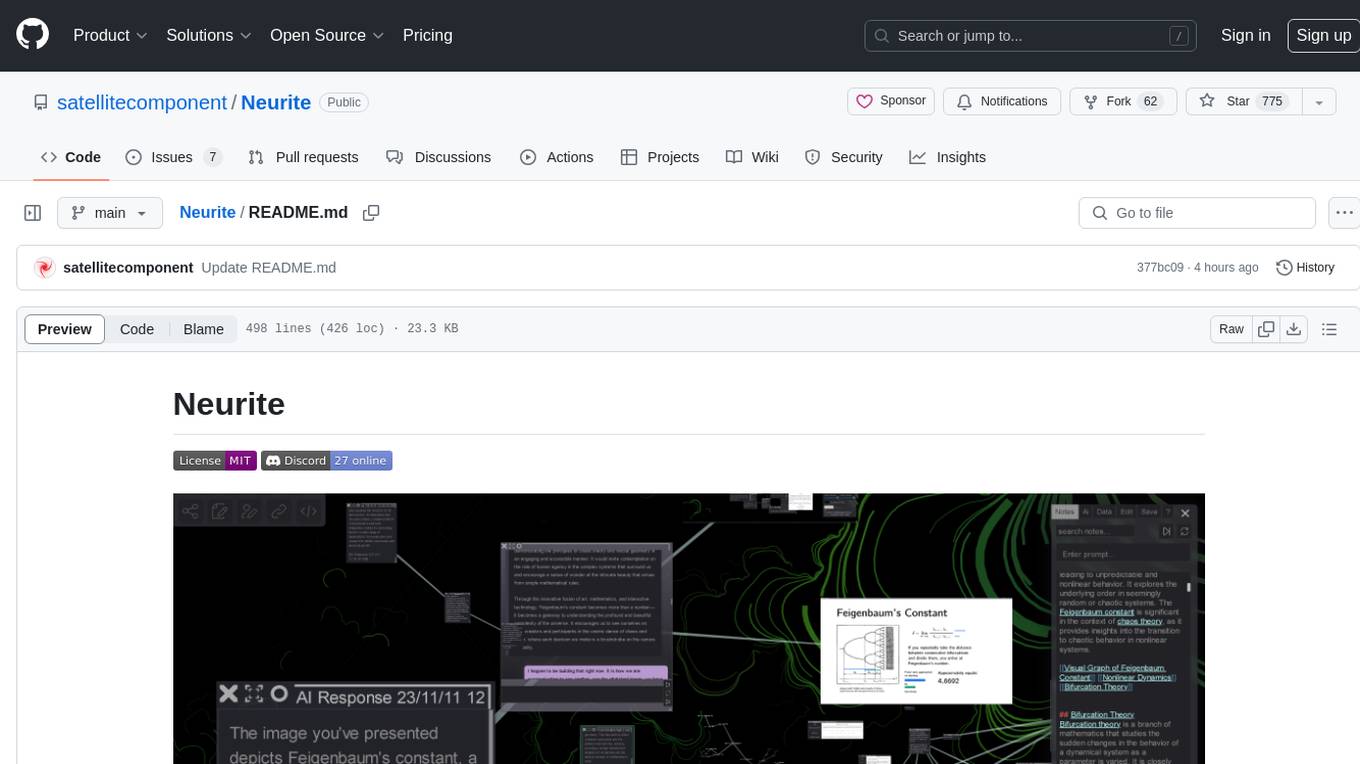
Neurite is an innovative project that combines chaos theory and graph theory to create a digital interface that explores hidden patterns and connections for creative thinking. It offers a unique workspace blending fractals with mind mapping techniques, allowing users to navigate the Mandelbrot set in real-time. Nodes in Neurite represent various content types like text, images, videos, code, and AI agents, enabling users to create personalized microcosms of thoughts and inspirations. The tool supports synchronized knowledge management through bi-directional synchronization between mind-mapping and text-based hyperlinking. Neurite also features FractalGPT for modular conversation with AI, local AI capabilities for multi-agent chat networks, and a Neural API for executing code and sequencing animations. The project is actively developed with plans for deeper fractal zoom, advanced control over node placement, and experimental features.
README:
💡 neurite.network unleashes a new dimension of digital interface...
🧩 Drawing from chaos theory and graph theory, Neurite unveils the hidden patterns and intricate connections that shape creative thinking.
For over a year, we've been iterating out a virtually limitless workspace that blends the mesmerizing complexity of fractals with contemporary mind mapping technique.
|
The Mandelbrot Set is not just an aesthetic choice - fractal logic is ingrained into a countless number of natural and constructed phenomena - from polynomial equations, to art and music - even the cosmic web. 🌀 Fractals act as the cross-disciplinary framework for non-integer dimensional thought - where conventional notions of 4D spacetime are put into question. The goal of this project is to grow agentic graphs of fractal creativity & collaboration. |
neurite.network is unique in its ability to seamlessly navigate the Mandelbrot set in real time! 🚀
Movements through the fractal are no longer interrupted at each step. Instead, the rendering persists and regenerates as you interact...
Nodes represent text, images, videos, code, and AI agents. Together, they thread a personalized microcosm of your thoughts and inspirations. 🔭
neurite.network connects physics simulation of graphs with an underlying fractal topology to kinematically define interactive, iterative, and modular graphs of ideation.
Whether you're a researcher, writer, artist, developer, educator, or simply a curious thinker, Neurite offers a departure from the conventional interface. It's an interactive landscape tracing your ever-branching pathways of thought.
🌐 Available through Github Pages: neurite.network 🌐
Warning: Contains zooming, flashing lights, and colors which may not currently be suitable for people with photosensitive epilepsy.
🌱 This is an open-source project in active development, feel feel to join our team on Discord
- Introduction
- How to Use Neurite
- Synchronized Knowledge Management
- FractalGPT
- Multi-Agent UI
- User Guide
- Local Server Setup
- Neural API
- Future of Neurite
- Gallery
📚 Neurite lets you embed anything - text, photos, audio, video, PDFs, AI, and webpages - directly within the Mandelbrot set.
Drag and drop or Paste local files and web content straight into the fractal.
| Category | Key/Combination | Action |
|---|---|---|
| Navigation | Click and drag |
Move around |
Scroll |
Zoom through the fractal | |
| Node Essentials | Shift + double click |
Create text node |
Shift |
Freeze time | |
Hold Shift + click |
Connect two nodes | |
Double click |
Anchor a node | |
| Node Selection & Arrangement | Alt/Option + Drag Node |
Arrange the node (avoids text selection) |
Alt/Option + Click |
Select nodes | |
Alt/Option + Drag Canvas |
Select multiple nodes | |
Arrow Keys |
Move selected nodes | |
d |
Scale selected nodes down | |
f |
Scale selected nodes up | |
| Fractal Controls | Edit Tab |
Main sliders for fractal rendering and color |
Alt/Option + f |
Freeze the currently displayed fractal lines | |
Alt/Option + c |
Clear any frozen lines | |
Alt/Option + s |
Save the fractal lines as a PNG |
Custom ## title and [[reference]] tags can be set in the Zettelkasten Settings. To access the Zettelkasten Settings, click the note icon in the top left corner of the dropdown.
*Full controls are listed in the ? tab within Neurite's main dropdown.
UI Tips
-
Optimal Node Placement: Zoom inScrollto create space for new nodes to ensure they have room to expand. -
Managing Windows: Drag windows by their title bar and resize by scrolling while holdingShift. -
Freezing Nodes: HoldShiftto freeze nodes in place, thenDouble Clicknodes to anchor them in place. -
Ai Tutorial: The HOW-TO checkbox sends a context message to the AI that allows it to answer some questions about Neurite.
|
Markdown formatted, bi-directional synchronization between UI-focused Mind-Mapping and text-based hyperlinking.
|
|
|
Build your Zettelkasten through UI interactions in the Mind Map, and reciprocally shape the Mind Map through text-based note-taking in the Zettelkasten. This navigational fluidity offers unprecedented control over both the granular and macroscopic perspectives of your information.
|
In Neurite, you don't just interact with AI; you grow its contextual memory, thanks to:
Fractals are the rabbit hole for endless exploration of thought! |
flow-based Ai-Agents ⛓️💭🔄 Message Looping: Initiate conversational threads across connected AI nodes.
|
| Local | Cloud |
|---|---|
| Ollama | OpenAI |
| transformers.js | Groq |
| Custom | Anthropic |
| Plugin | Description |
|---|---|
| Auto Mode | Enable the AI to recursively generate its own prompts. |
| Long-Term Memory | Utilize nodal recall through our vector-embedded search of your notes and conversation. Includes experimental ability to forget certain memories. |
| Experimental Code Editor |
|
| Web Search | Utilize the Google programmable search API to retrieve webpages that can be sent as context to the AI. |
| Understands Webpages and PDFs | Leverage a local vector database to extend the AI's context window. |
| Wikipedia Results | Retrieve the top 3 Wikipedia results or shuffle through the top 20. |
| Wolfram Alpha Results | Display Wolfram Pods as nodes. |
All API keys can be input through the AI tab in the menu dropdown.
either:
- Clone the repository
- Navigate to the cloned directory in your terminal (either main or local-ai branch)
- Install any necessary global dependencies when running the below, (Vite)
npm install
npm run build
npm start
*optionally run npm start:host to access Neurite from devices connected to the same network.
- Navigate to localhost:8080 in your browser.
- Ensure the Localhost Servers are running to leverage Neurite's full capabilities.
The Localhost Servers are an important component of Neurite that serve as an optional backend and enable complete functionality.
Download Localhost Servers here.
*alternatively clone the entire repo.
The servers enable the local Vector Database, webpage/pdf text extraction, Wolfram Alpha, and Wikipedia.
- The localhost servers require npm and Node.js
- Without any servers running, Wolfram, Wiki, the Vector Database and Webpage extractions will not function.
- All servers can be run with one command. Download the Localhost Servers folder, or find it in your cloned directory. Once navigated to the Localhost Servers folder in your command line, run
node start_servers.js
This will install and run all of the servers at once. They'll work on our Github pages host of Neurite, or any other way you locally access the interface.
As of our recent update, the servers now support an Ai proxy that connects Neurite to any inference backend.
-
Search: Our distinctive search mechanism transports you through your intricate web of thoughts, directly zooming to the node you are looking for. The navigational experience isn't just a gimmick; it also helps to reinforce the spatial memory of where that piece of information resides within the larger framework. -
Saving: Your networks can be saved within the browser cache, or downloaded as a .txt file. Drag the .txt file into the save box, click load on the imported file, then click the second load button to display the network. 💾 Saving has been significantly enhanced! Now, node interactivity, fractal settings, and the Zettelkasten sync all fully restore when loading networks from the save tab... -
Zettelkasten and Mind Mapping: Create nodes through custom-defined syntax, or create nodes through UI interaction within our fractal workspace, who's contents are bi-directionally linked to the main Zettelkasten document. -
Fractals: We achieve real-time navigation of the Mandelbrot set by capturing a sparse set of points from the fractal and connecting them through SVGs. From there, we dynamically adapt the level of detail based on your viewport and cursor position. This evolving method is what ensures seamless fractal generation, interaction, as well as an expanding array of customizability options.
Neurite realizes tapestry of thought reasoning for Ai, all within our innovative real-time Mandelbrot visualization.
- Talk to the custom GPT, Neurite GPT with access to Neurite's code and readme. (This is not the ai that interacts with Neurite itself)
|
|
This feature is a terminal that allows you to execute Neurite's code from within Neurite itself. Included with the function calling panel update is our Neural API. The Neural API is a growing collection of existing features within Neurite, made for sequencing animations of function calls. The current features include:
You can call on GPT to construct the sequences of function calls itself. It has access to the documentation. For the current documentation, try calling the below from within the function panel: The current Neural API documentation will display in your call history for the function calling panel as well as in your browser console. There will be more information on this soon. This is a new feature in initial release. |
Neurite is a recursive environment for generating ideas. The project combines fractals, mind-mapping, and ai to enable an experimental, yet powerful playground for research, code generation, writing, learning, and visualizing thought.
🚧 Neurite is in active development. 🚧
✅ Ollama (local Ai)
✅ local embeddings
- VR
🔄 deeper fractal zoom
✅ Global Function Calling
✅ Cellular Automata
✅ Multi-Agent Chat
✅ Advanced Control over Node Placement
✅ color selection
✅ adjust fractal generation (width, length, max lines, speed)
✅ screen recording
✅ Improved Saving
🔄 accessibility
✅ Expanded fractal types. (Mandelbrot, Burning Ship, Julia Sets)
- drawing-tool
🔄 Experimental Features
🔄 user feedback/bug fixes
🔄 pull requests
🚧
If you are a developer who is interested in contributing to this project, contact us at [email protected] or visit our discord 🔗
For Tasks:
Click tags to check more tools for each tasksFor Jobs:
Alternative AI tools for Neurite
Similar Open Source Tools

Neurite
Neurite is an innovative project that combines chaos theory and graph theory to create a digital interface that explores hidden patterns and connections for creative thinking. It offers a unique workspace blending fractals with mind mapping techniques, allowing users to navigate the Mandelbrot set in real-time. Nodes in Neurite represent various content types like text, images, videos, code, and AI agents, enabling users to create personalized microcosms of thoughts and inspirations. The tool supports synchronized knowledge management through bi-directional synchronization between mind-mapping and text-based hyperlinking. Neurite also features FractalGPT for modular conversation with AI, local AI capabilities for multi-agent chat networks, and a Neural API for executing code and sequencing animations. The project is actively developed with plans for deeper fractal zoom, advanced control over node placement, and experimental features.
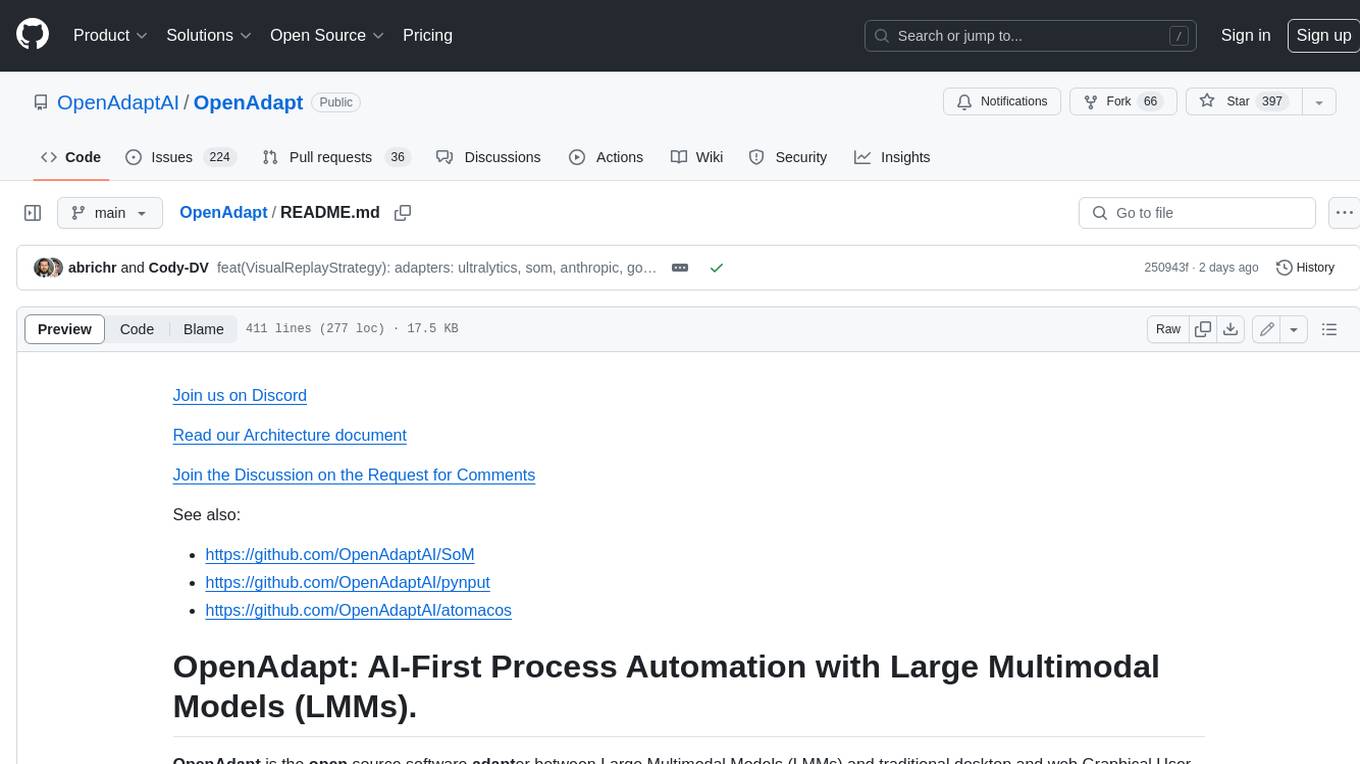
OpenAdapt
OpenAdapt is an open-source software adapter between Large Multimodal Models (LMMs) and traditional desktop and web Graphical User Interfaces (GUIs). It aims to automate repetitive GUI workflows by leveraging the power of LMMs. OpenAdapt records user input and screenshots, converts them into tokenized format, and generates synthetic input via transformer model completions. It also analyzes recordings to generate task trees and replay synthetic input to complete tasks. OpenAdapt is model agnostic and generates prompts automatically by learning from human demonstration, ensuring that agents are grounded in existing processes and mitigating hallucinations. It works with all types of desktop GUIs, including virtualized and web, and is open source under the MIT license.
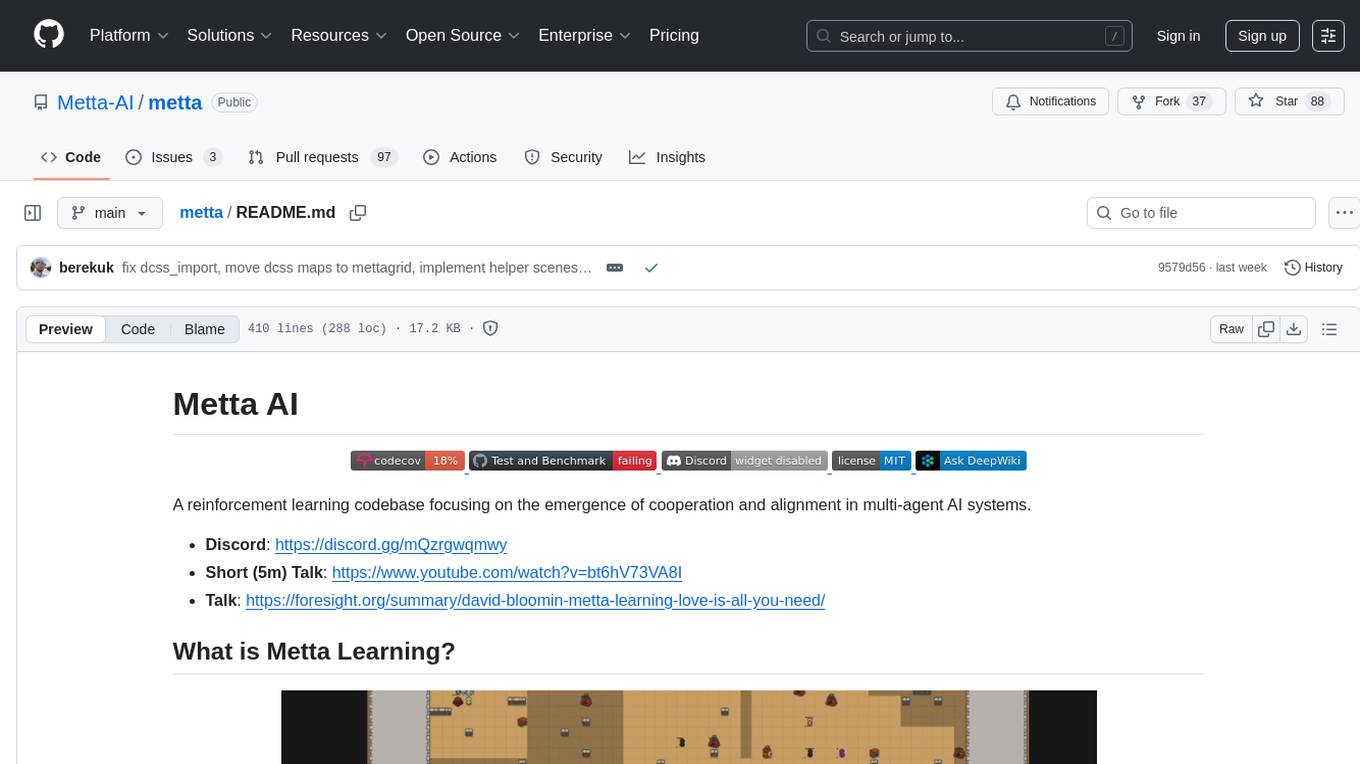
metta
Metta AI is an open-source research project focusing on the emergence of cooperation and alignment in multi-agent AI systems. It explores the impact of social dynamics like kinship and mate selection on learning and cooperative behaviors of AI agents. The project introduces a reward-sharing mechanism mimicking familial bonds and mate selection to observe the evolution of complex social behaviors among AI agents. Metta aims to contribute to the discussion on safe and beneficial AGI by creating an environment where AI agents can develop general intelligence through continuous learning and adaptation.
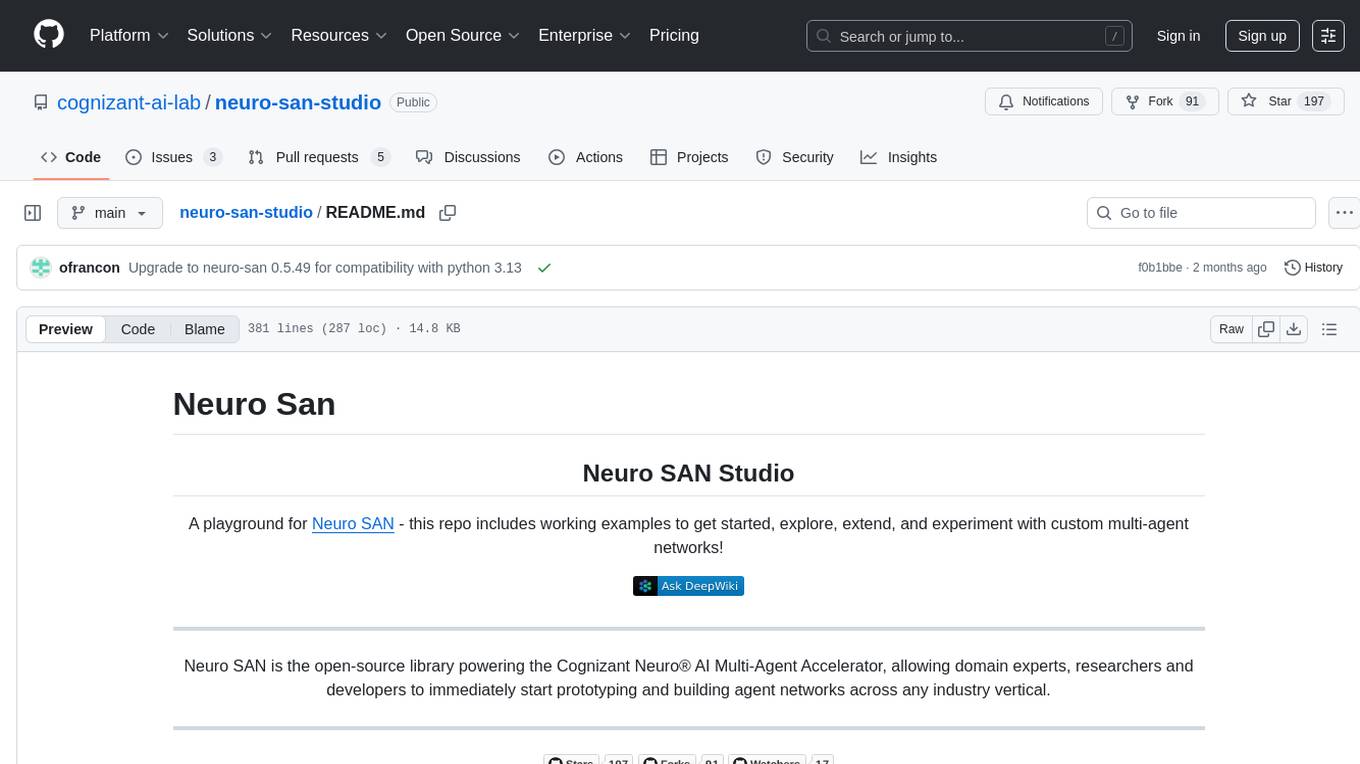
neuro-san-studio
Neuro SAN Studio is an open-source library for building agent networks across various industries. It simplifies the development of collaborative AI systems by enabling users to create sophisticated multi-agent applications using declarative configuration files. The tool offers features like data-driven configuration, adaptive communication protocols, safe data handling, dynamic agent network designer, flexible tool integration, robust traceability, and cloud-agnostic deployment. It has been used in various use-cases such as automated generation of multi-agent configurations, airline policy assistance, banking operations, market analysis in consumer packaged goods, insurance claims processing, intranet knowledge management, retail operations, telco network support, therapy vignette supervision, and more.
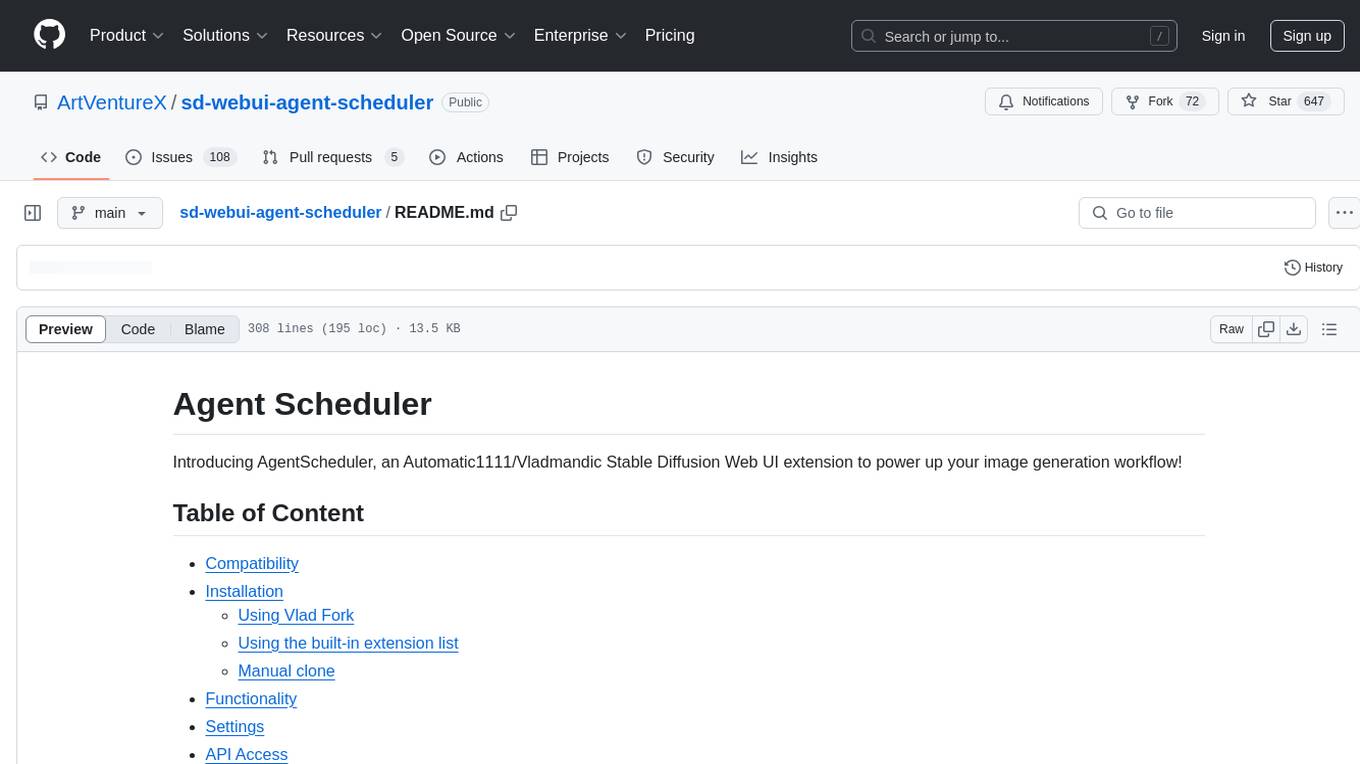
sd-webui-agent-scheduler
AgentScheduler is an Automatic/Vladmandic Stable Diffusion Web UI extension designed to enhance image generation workflows. It allows users to enqueue prompts, settings, and controlnets, manage queued tasks, prioritize, pause, resume, and delete tasks, view generation results, and more. The extension offers hidden features like queuing checkpoints, editing queued tasks, and custom checkpoint selection. Users can access the functionality through HTTP APIs and API callbacks. Troubleshooting steps are provided for common errors. The extension is compatible with latest versions of A1111 and Vladmandic. It is licensed under Apache License 2.0.
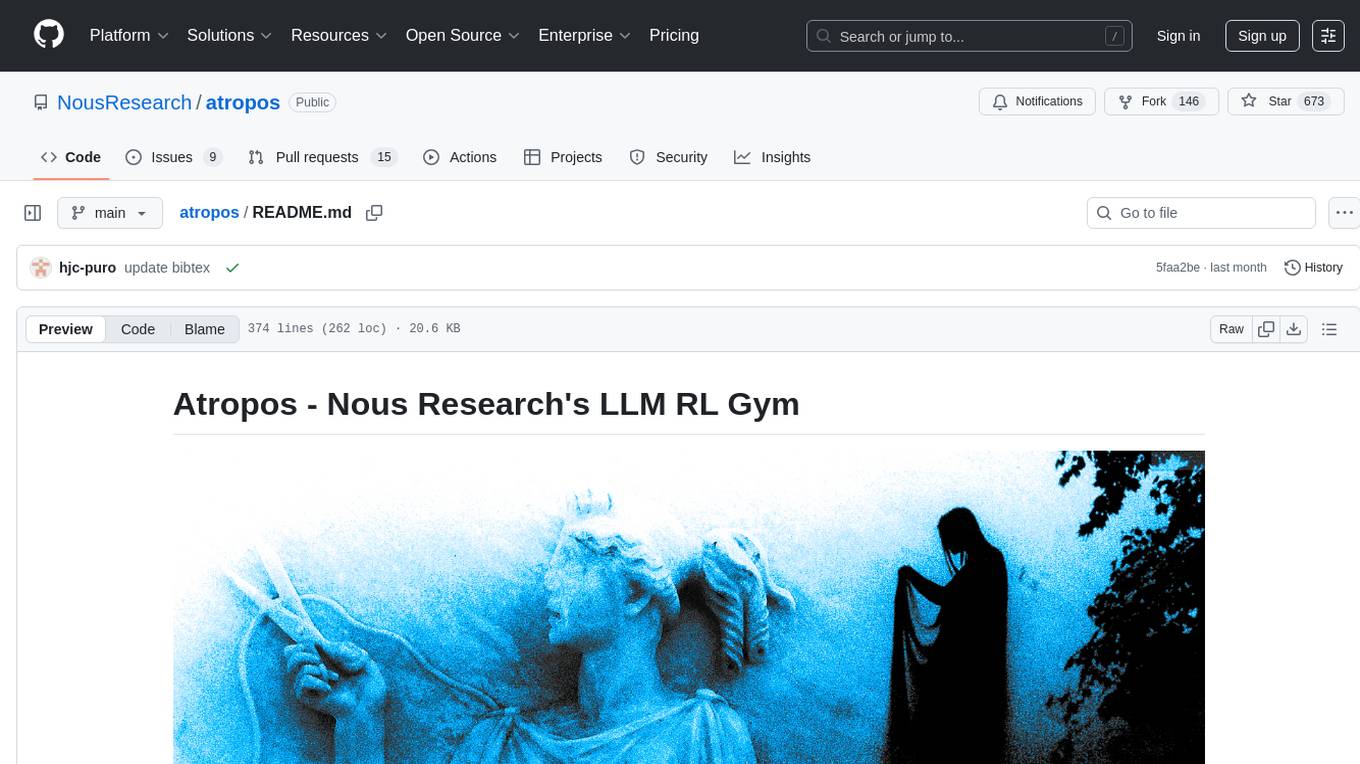
atropos
Atropos is a robust and scalable framework for Reinforcement Learning Environments with Large Language Models (LLMs). It provides a flexible platform to accelerate LLM-based RL research across diverse interactive settings. Atropos supports multi-turn and asynchronous RL interactions, integrates with various inference APIs, offers a standardized training interface for experimenting with different RL algorithms, and allows for easy scalability by launching more environment instances. The framework manages diverse environment types concurrently for heterogeneous, multi-modal training.
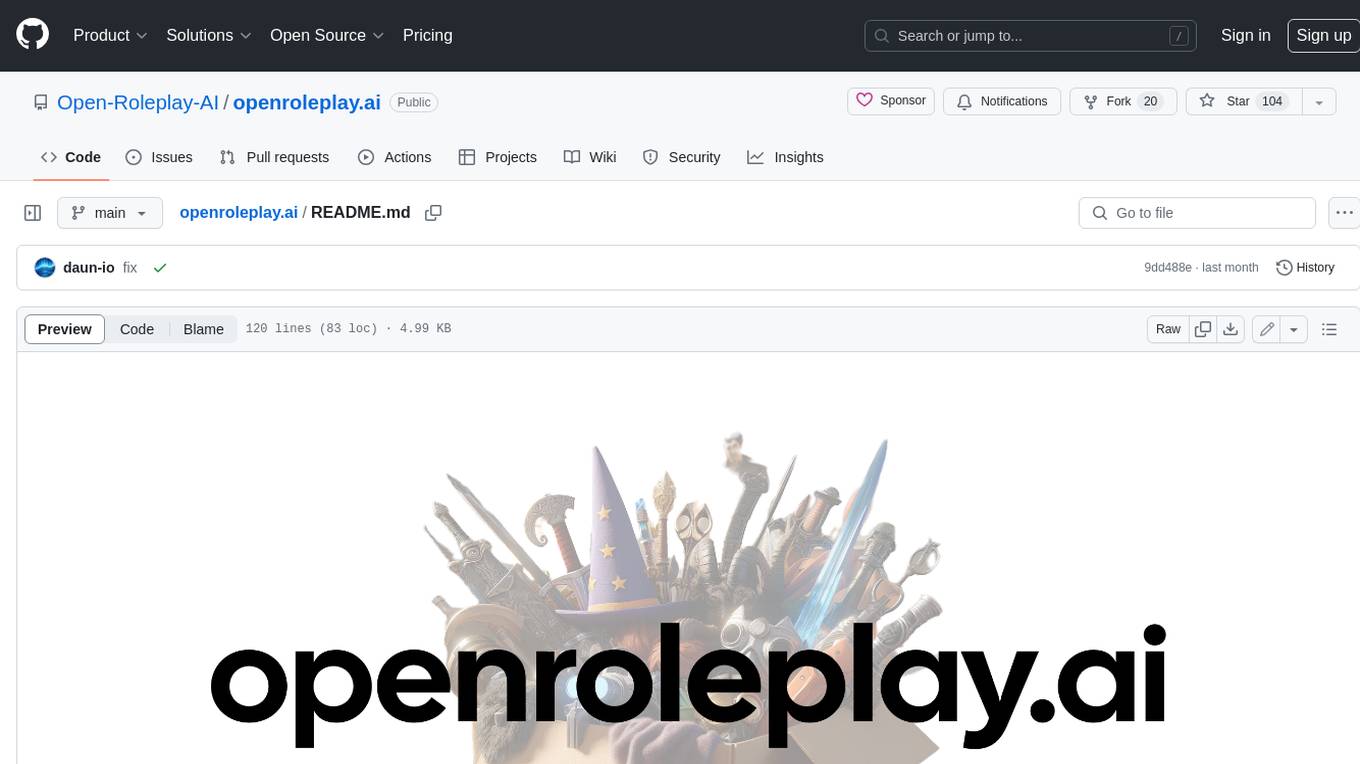
openroleplay.ai
Open Roleplay is an open-source alternative to Character.ai. It allows users to create their own AI characters, customize them, and generate images and voices for them. Open Roleplay also supports group chat and automatic translation. The tool is built with Next.js, React.js, Tailwind CSS, Vercel, Convex, and Clerk.
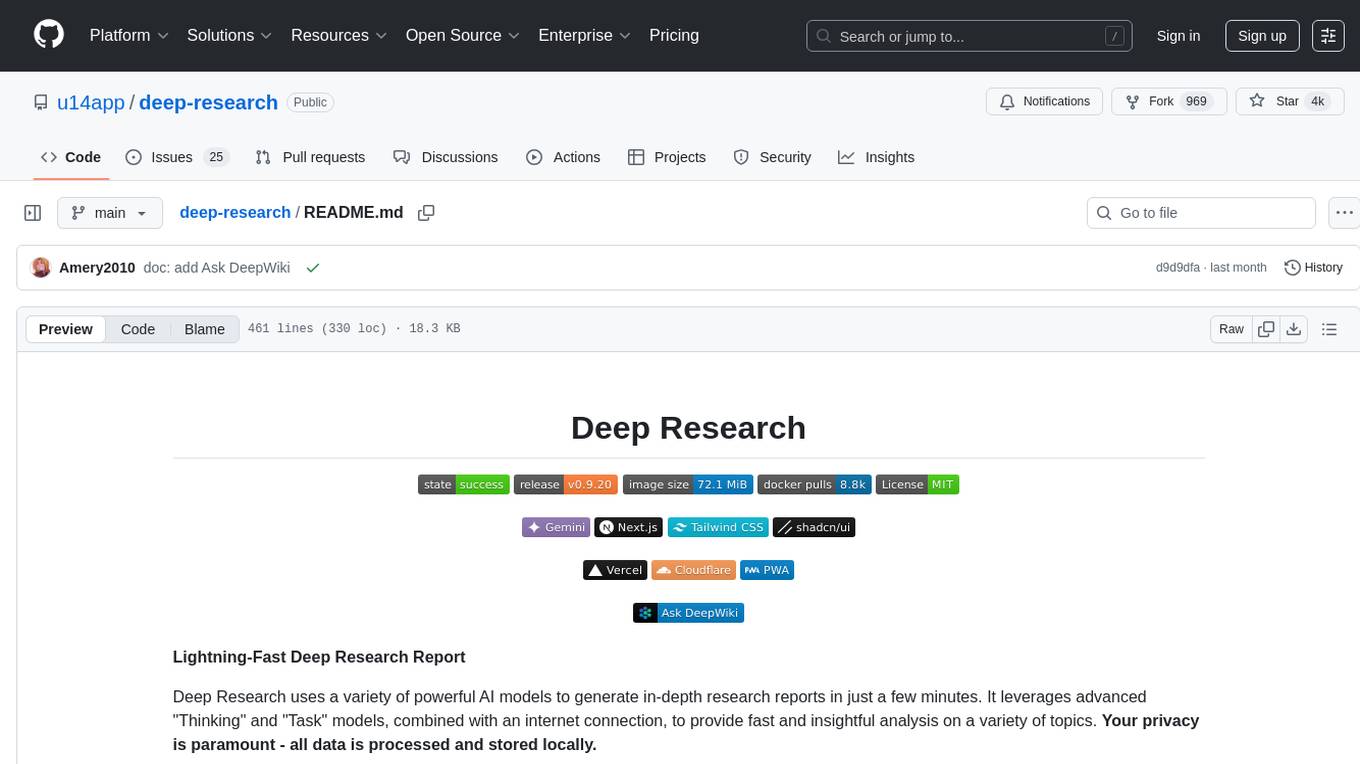
deep-research
Deep Research is a lightning-fast tool that uses powerful AI models to generate comprehensive research reports in just a few minutes. It leverages advanced 'Thinking' and 'Task' models, combined with an internet connection, to provide fast and insightful analysis on various topics. The tool ensures privacy by processing and storing all data locally. It supports multi-platform deployment, offers support for various large language models, web search functionality, knowledge graph generation, research history preservation, local and server API support, PWA technology, multi-key payload support, multi-language support, and is built with modern technologies like Next.js and Shadcn UI. Deep Research is open-source under the MIT License.
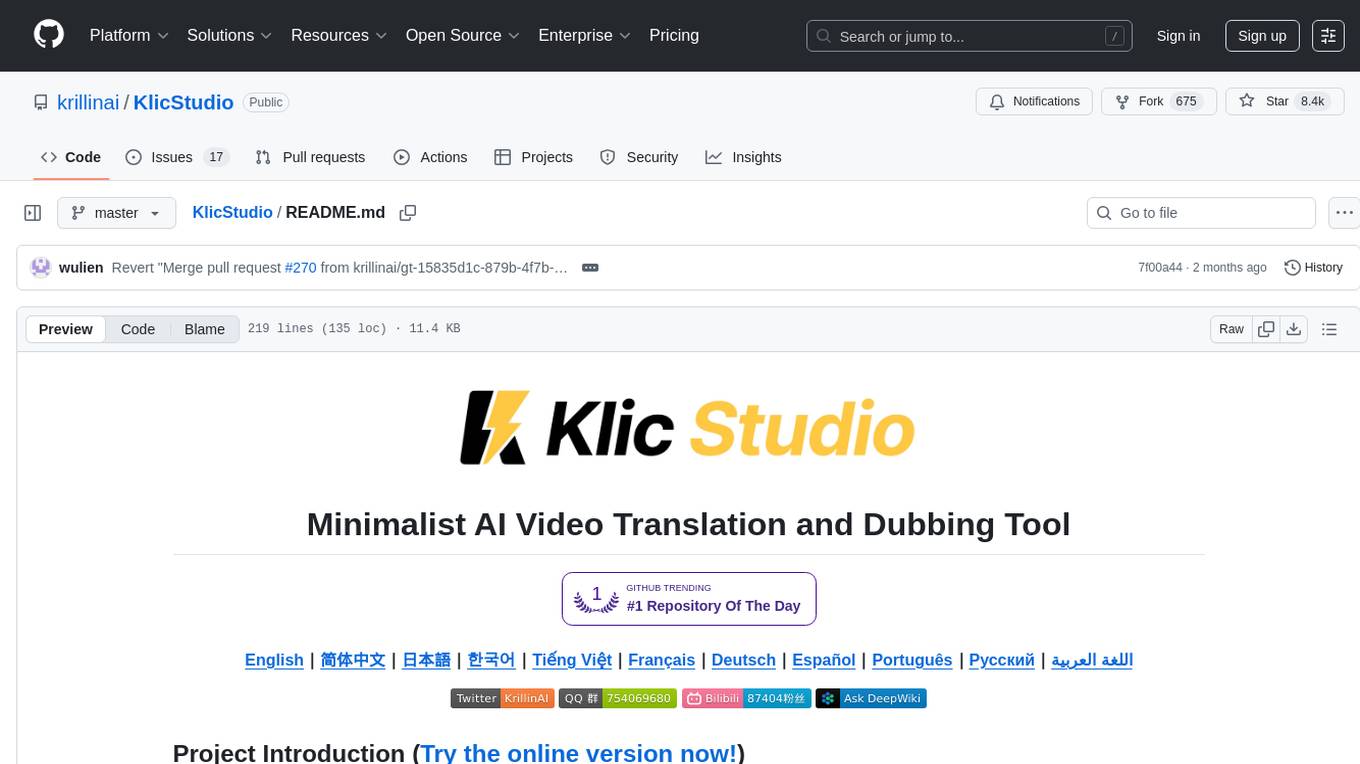
KlicStudio
Klic Studio is a versatile audio and video localization and enhancement solution developed by Krillin AI. This minimalist yet powerful tool integrates video translation, dubbing, and voice cloning, supporting both landscape and portrait formats. With an end-to-end workflow, users can transform raw materials into beautifully ready-to-use cross-platform content with just a few clicks. The tool offers features like video acquisition, accurate speech recognition, intelligent segmentation, terminology replacement, professional translation, voice cloning, video composition, and cross-platform support. It also supports various speech recognition services, large language models, and TTS text-to-speech services. Users can easily deploy the tool using Docker and configure it for different tasks like subtitle translation, large model translation, and optional voice services.
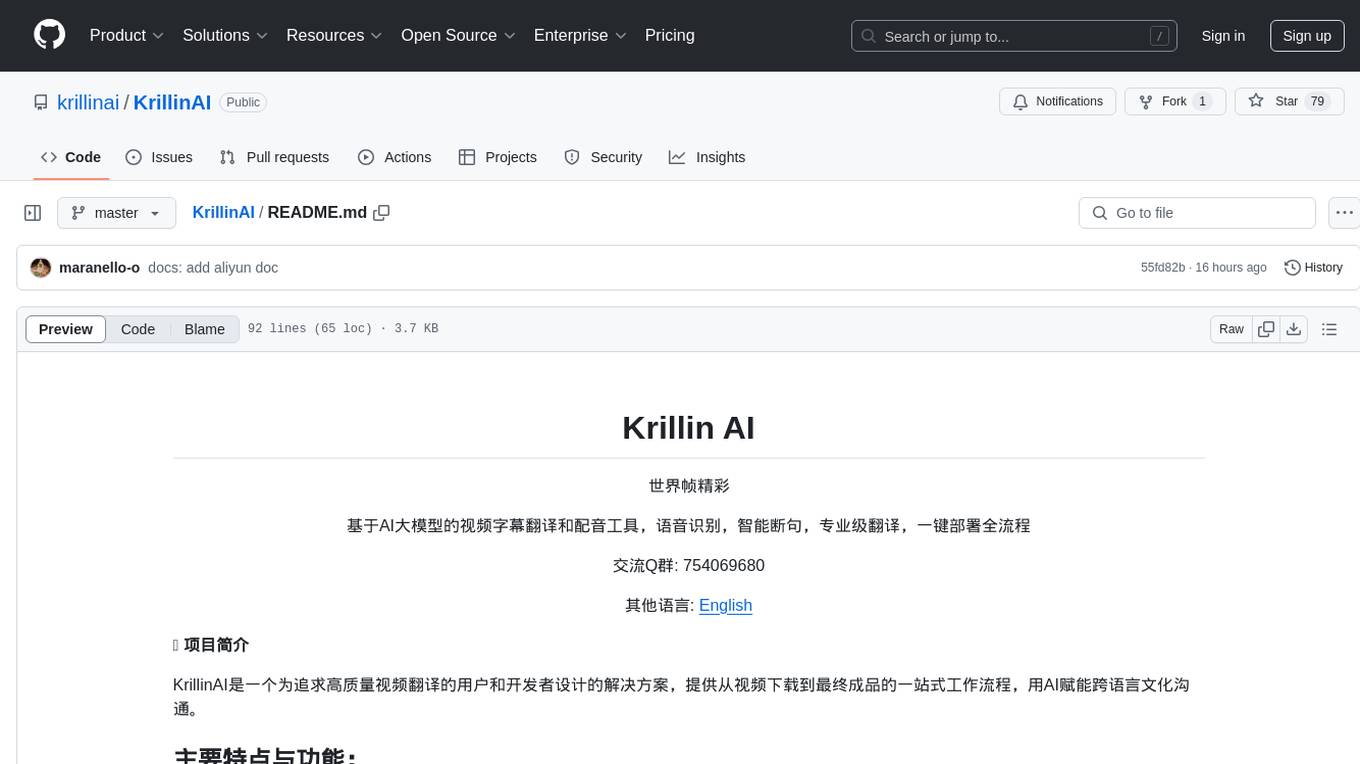
KrillinAI
KrillinAI is a video subtitle translation and dubbing tool based on AI large models, featuring speech recognition, intelligent sentence segmentation, professional translation, and one-click deployment of the entire process. It provides a one-stop workflow from video downloading to the final product, empowering cross-language cultural communication with AI. The tool supports multiple languages for input and translation, integrates features like automatic dependency installation, video downloading from platforms like YouTube and Bilibili, high-speed subtitle recognition, intelligent subtitle segmentation and alignment, custom vocabulary replacement, professional-level translation engine, and diverse external service selection for speech and large model services.
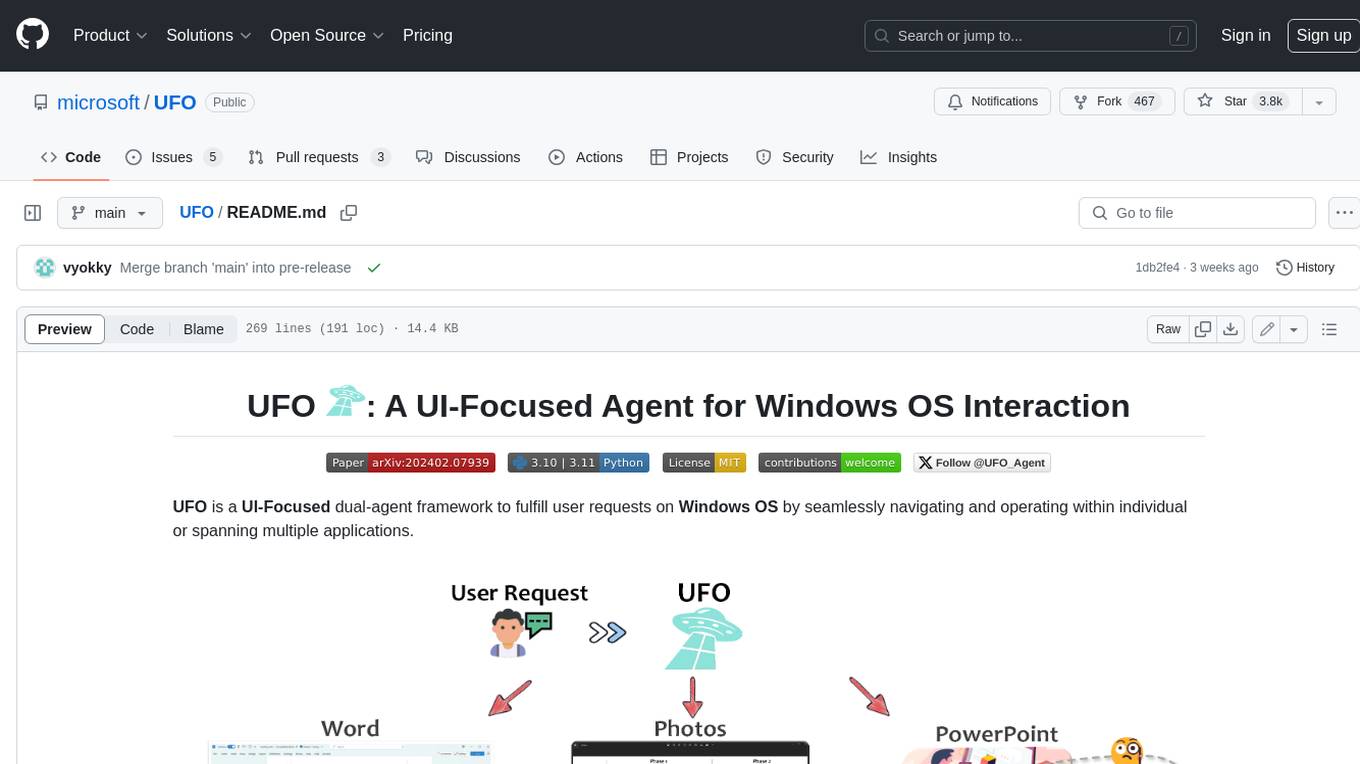
UFO
UFO is a UI-focused dual-agent framework to fulfill user requests on Windows OS by seamlessly navigating and operating within individual or spanning multiple applications.
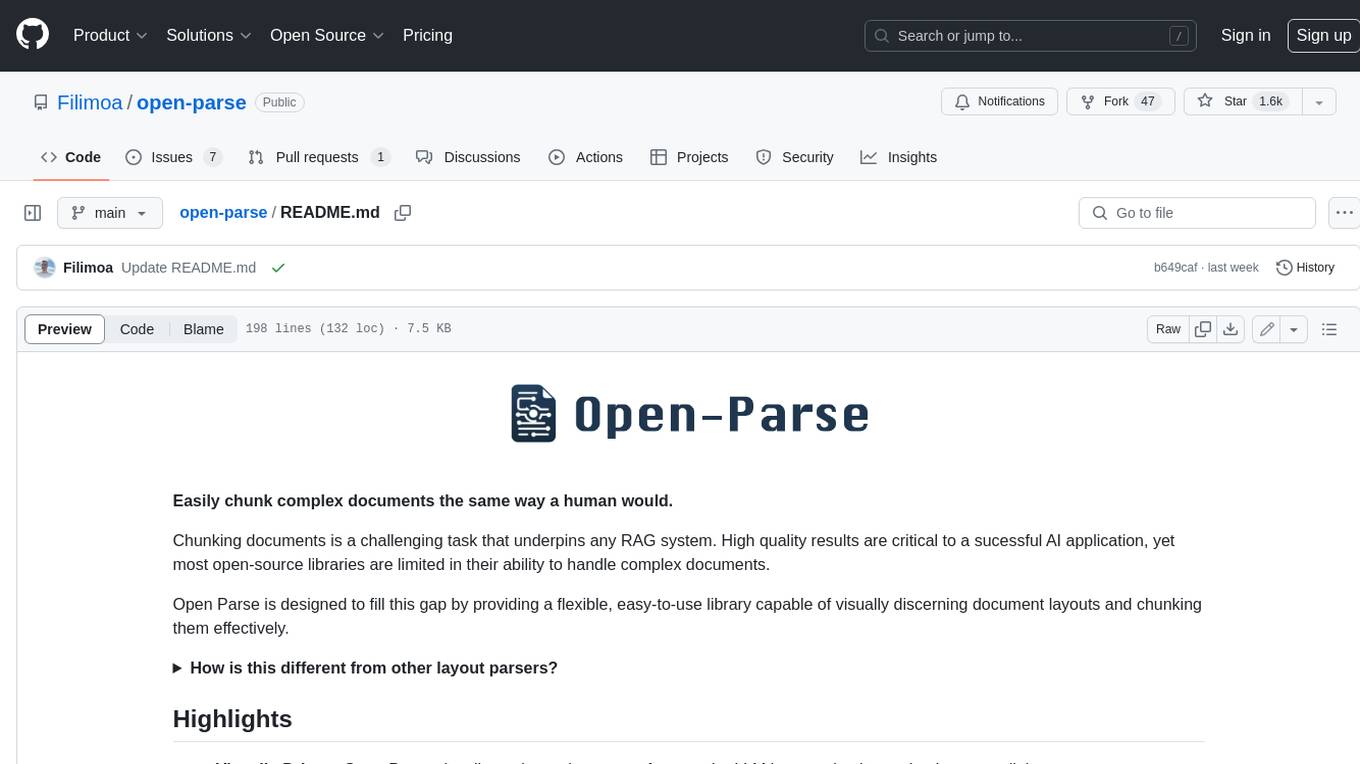
open-parse
Open Parse is a Python library for visually discerning document layouts and chunking them effectively. It is designed to fill the gap in open-source libraries for handling complex documents. Unlike text splitting, which converts a file to raw text and slices it up, Open Parse visually analyzes documents for superior LLM input. It also supports basic markdown for parsing headings, bold, and italics, and has high-precision table support, extracting tables into clean Markdown formats with accuracy that surpasses traditional tools. Open Parse is extensible, allowing users to easily implement their own post-processing steps. It is also intuitive, with great editor support and completion everywhere, making it easy to use and learn.
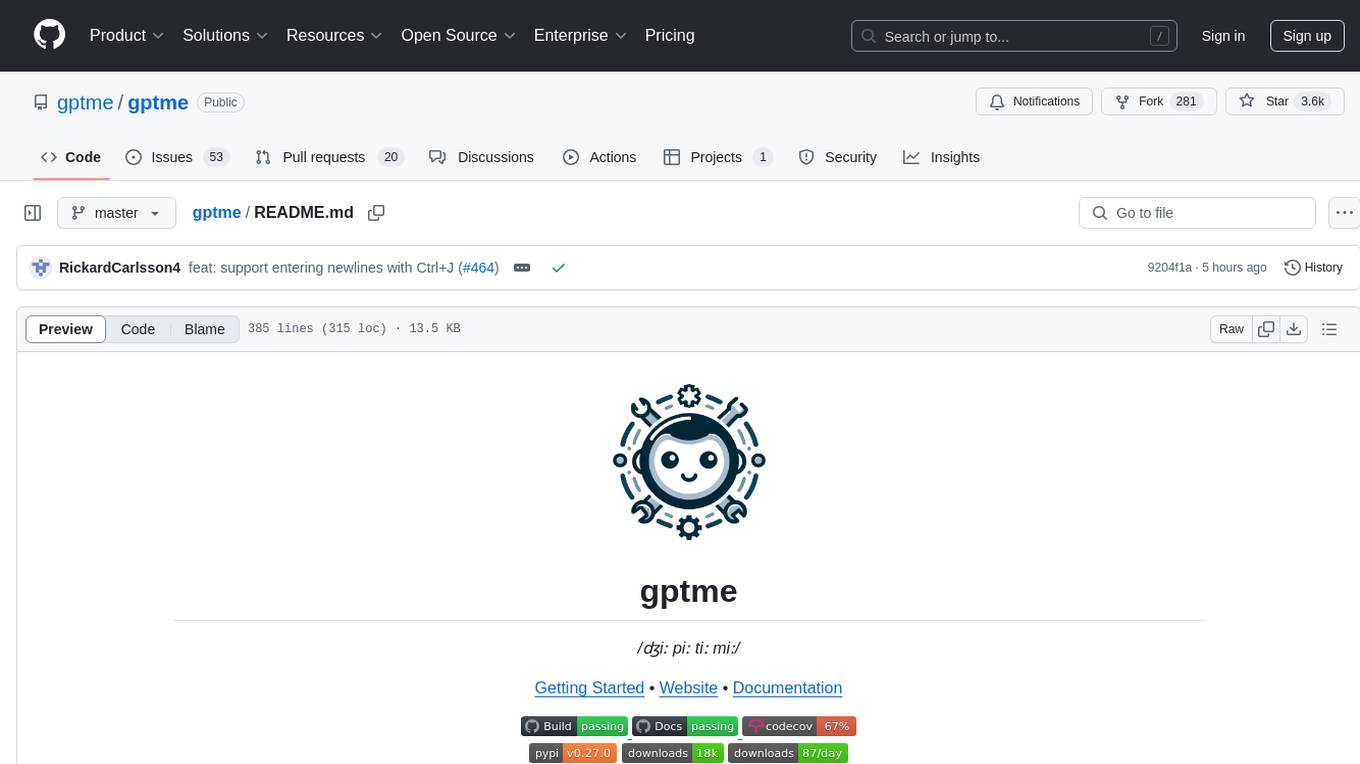
gptme
Personal AI assistant/agent in your terminal, with tools for using the terminal, running code, editing files, browsing the web, using vision, and more. A great coding agent that is general-purpose to assist in all kinds of knowledge work, from a simple but powerful CLI. An unconstrained local alternative to ChatGPT with 'Code Interpreter', Cursor Agent, etc. Not limited by lack of software, internet access, timeouts, or privacy concerns if using local models.
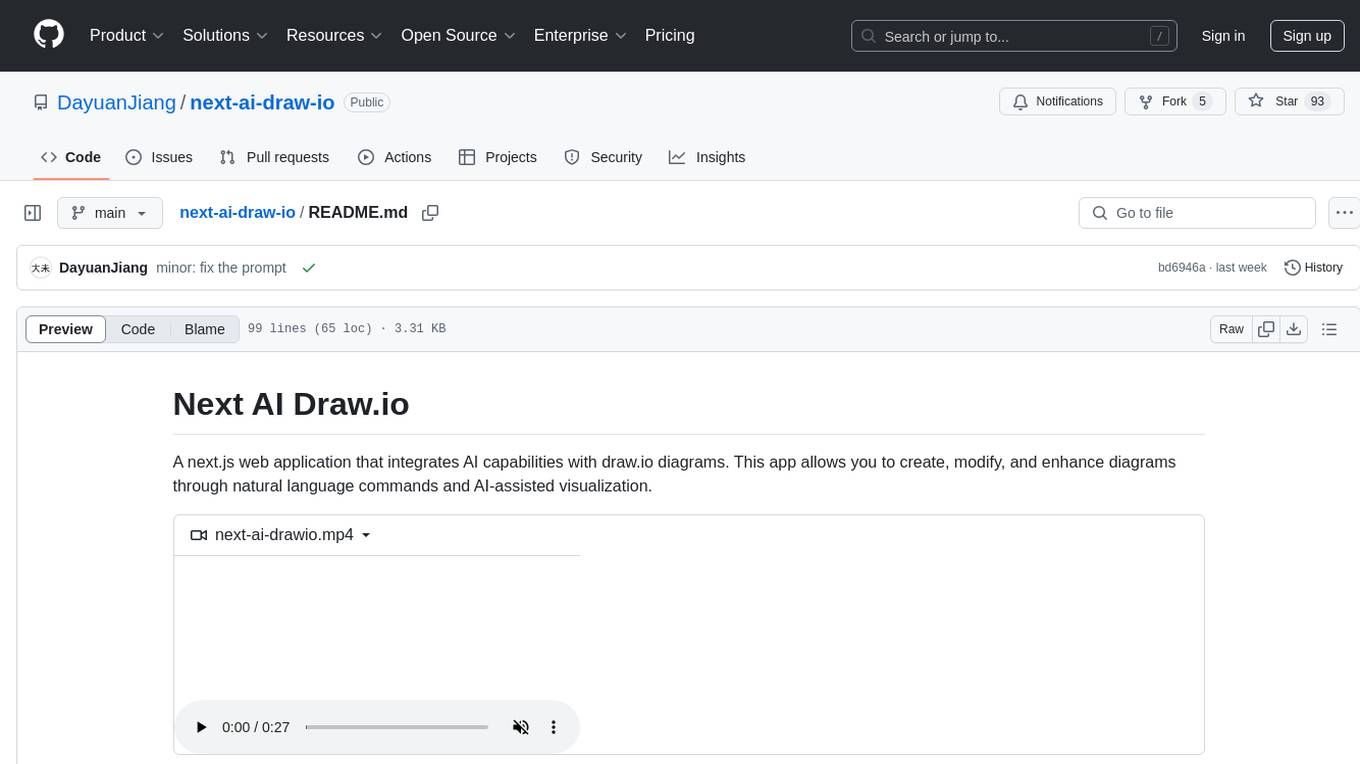
next-ai-draw-io
Next AI Draw.io is a next.js web application that integrates AI capabilities with draw.io diagrams. It allows users to create, modify, and enhance diagrams through natural language commands and AI-assisted visualization. Features include LLM-Powered Diagram Creation, Image-Based Diagram Replication, Diagram History, Interactive Chat Interface, and Smart Editing. The application uses Next.js for frontend framework, @ai-sdk/react for chat interface and AI interactions, and react-drawio for diagram representation and manipulation. Diagrams are represented as XML that can be rendered in draw.io, with AI processing commands to generate or modify the XML accordingly.
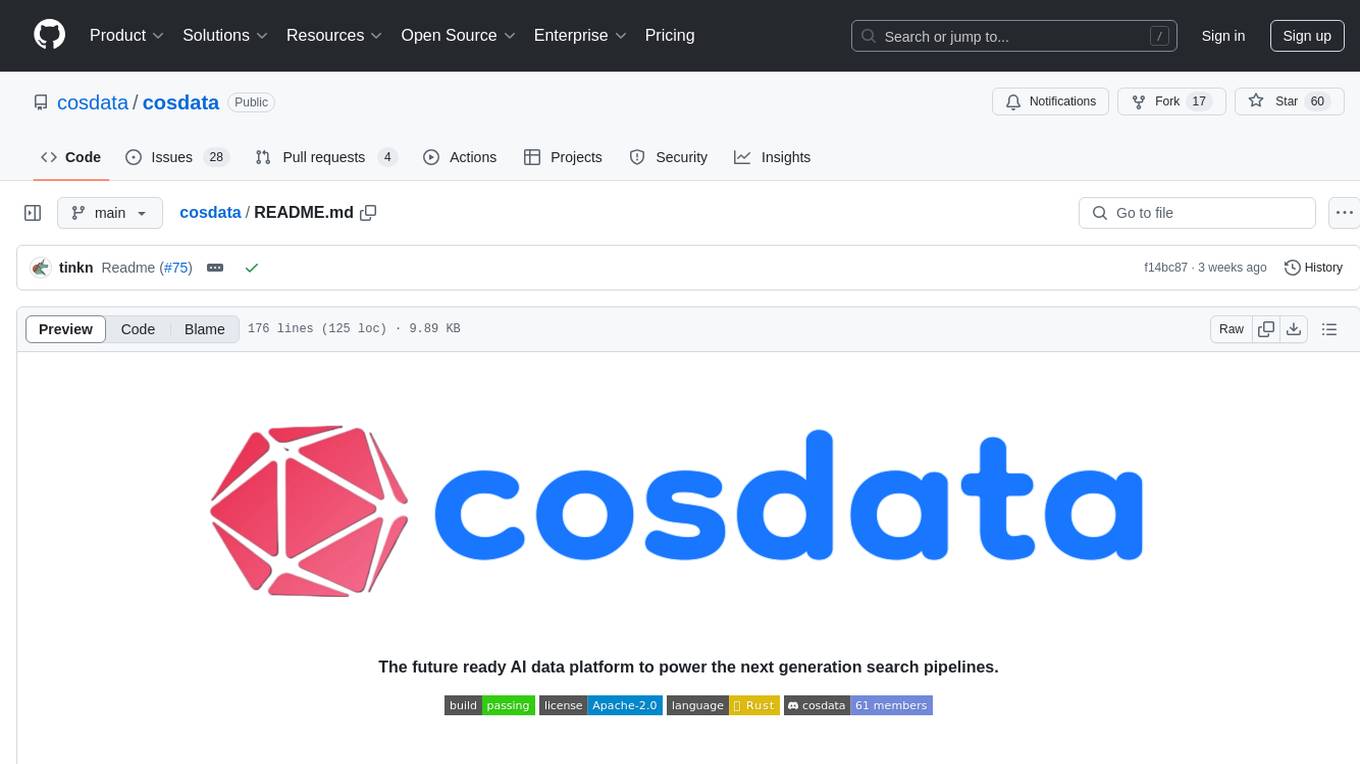
cosdata
Cosdata is a cutting-edge AI data platform designed to power the next generation search pipelines. It features immutability, version control, and excels in semantic search, structured knowledge graphs, hybrid search capabilities, real-time search at scale, and ML pipeline integration. The platform is customizable, scalable, efficient, enterprise-grade, easy to use, and can manage multi-modal data. It offers high performance, indexing, low latency, and high requests per second. Cosdata is designed to meet the demands of modern search applications, empowering businesses to harness the full potential of their data.
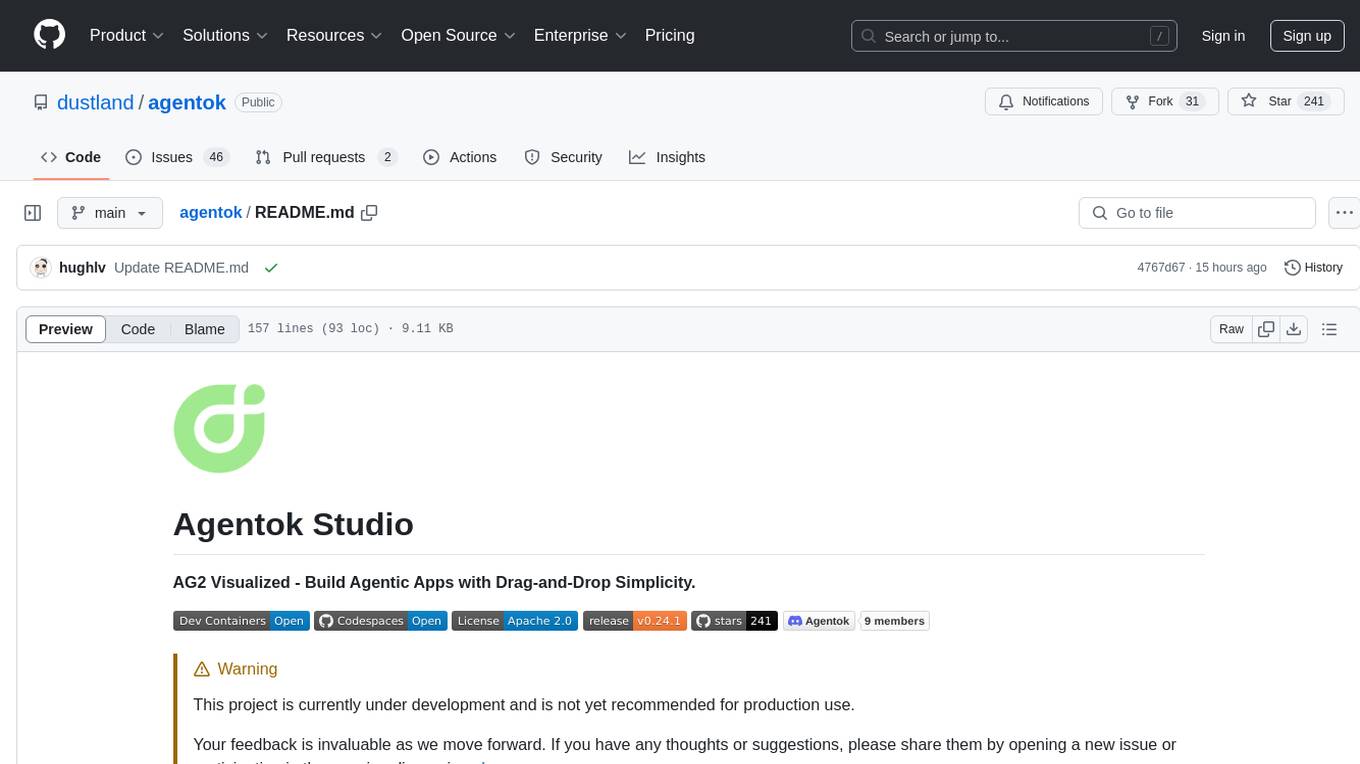
agentok
Agentok Studio is a tool built upon AG2, a powerful agent framework from Microsoft, offering intuitive visual tools to streamline the creation and management of complex agent-based workflows. It simplifies the process for creators and developers by generating native Python code with minimal dependencies, enabling users to create self-contained code that can be executed anywhere. The tool is currently under development and not recommended for production use, but contributions are welcome from the community to enhance its capabilities and functionalities.
For similar tasks
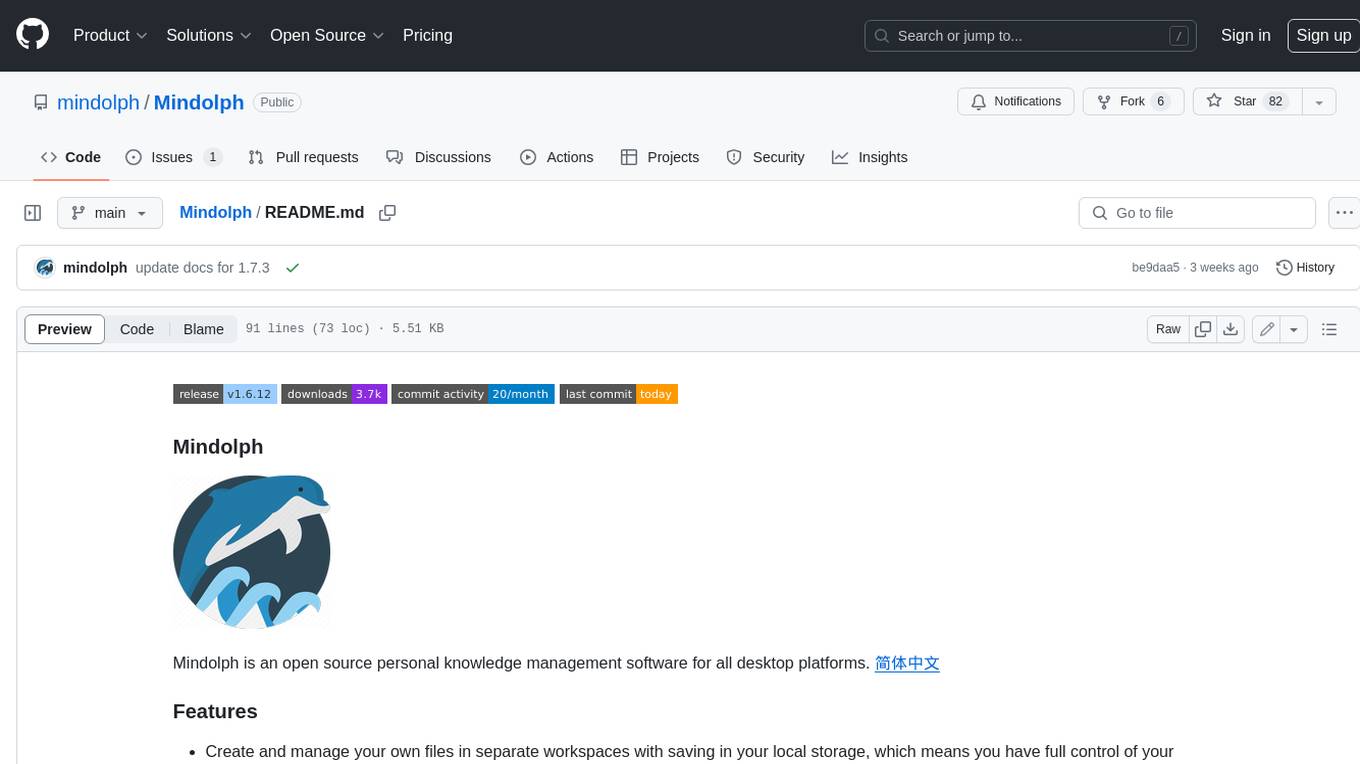
Mindolph
Mindolph is an open source personal knowledge management software for all desktop platforms. It allows users to create and manage their own files in separate workspaces with saving in their local storage, organize their files as a tree in their workspaces, and have multiple tabs for opening files instead of a single file window. Mindolph supports Mind Map, Markdown, PlantUML, CSV sheet, and plain text file formats. It also has features such as quickly navigating to files and searching text in files under a specific folder, editing mind maps easily and quickly with key shortcuts, supporting themes and providing some pre-defined themes, importing from other mind map formats, and exporting to other file formats.
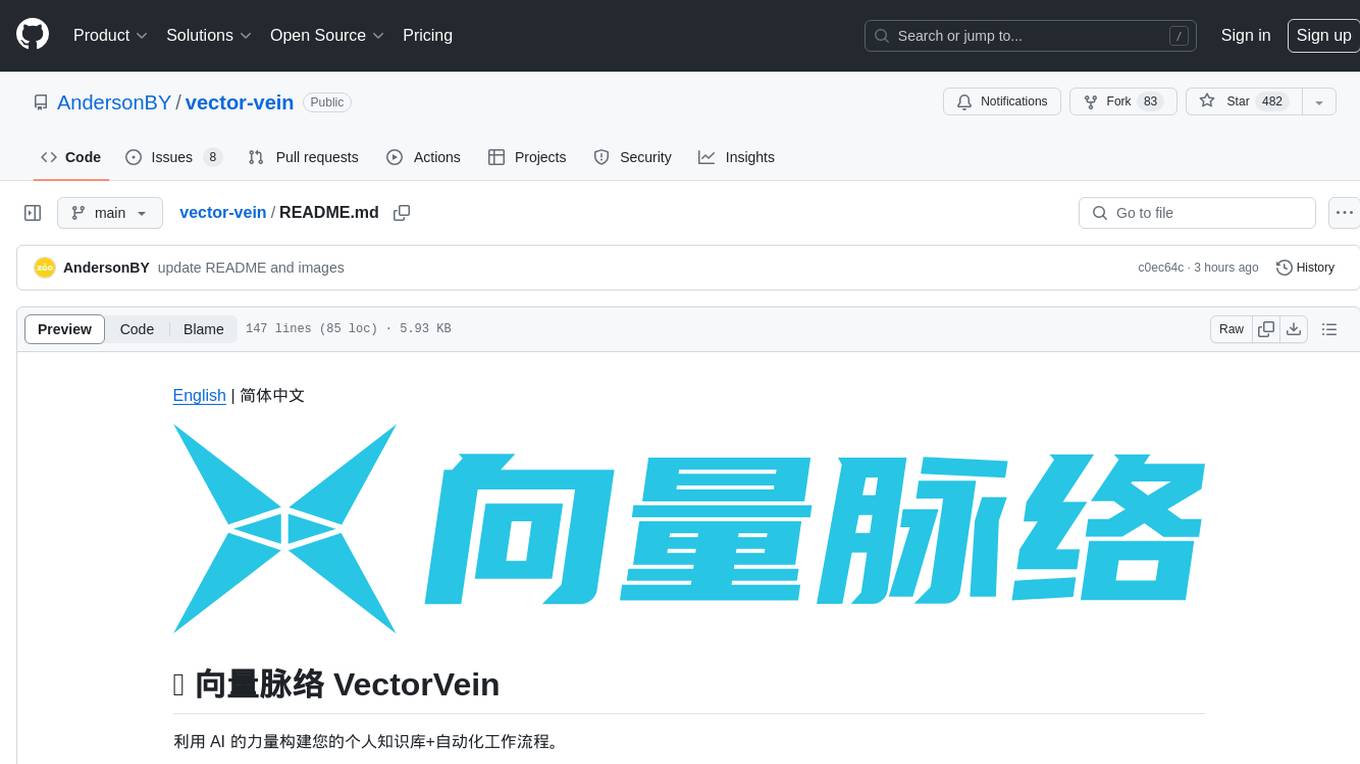
vector-vein
VectorVein is a no-code AI workflow software inspired by LangChain and langflow, aiming to combine the powerful capabilities of large language models and enable users to achieve intelligent and automated daily workflows through simple drag-and-drop actions. Users can create powerful workflows without the need for programming, automating all tasks with ease. The software allows users to define inputs, outputs, and processing methods to create customized workflow processes for various tasks such as translation, mind mapping, summarizing web articles, and automatic categorization of customer reviews.

Neurite
Neurite is an innovative project that combines chaos theory and graph theory to create a digital interface that explores hidden patterns and connections for creative thinking. It offers a unique workspace blending fractals with mind mapping techniques, allowing users to navigate the Mandelbrot set in real-time. Nodes in Neurite represent various content types like text, images, videos, code, and AI agents, enabling users to create personalized microcosms of thoughts and inspirations. The tool supports synchronized knowledge management through bi-directional synchronization between mind-mapping and text-based hyperlinking. Neurite also features FractalGPT for modular conversation with AI, local AI capabilities for multi-agent chat networks, and a Neural API for executing code and sequencing animations. The project is actively developed with plans for deeper fractal zoom, advanced control over node placement, and experimental features.
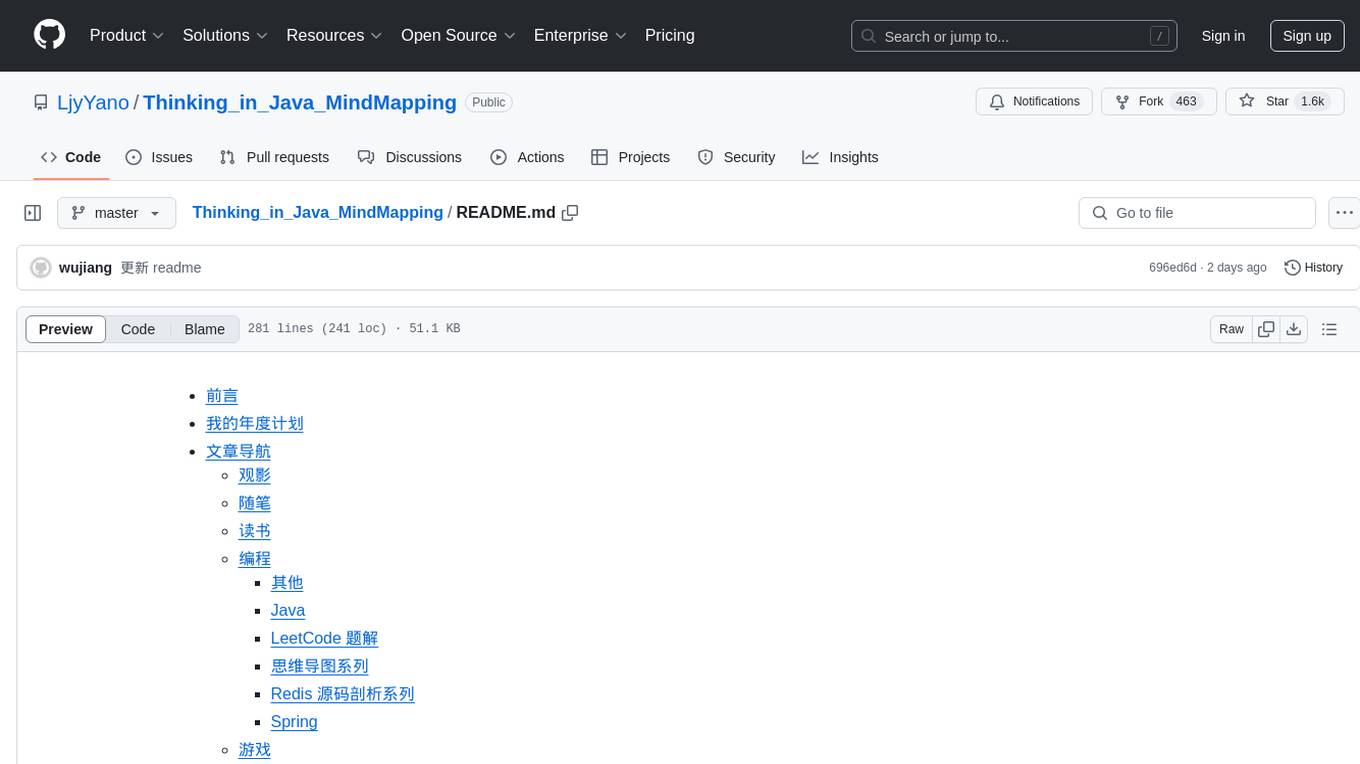
Thinking_in_Java_MindMapping
Thinking_in_Java_MindMapping is a repository that started as a project to create mind maps based on the book 'Java Programming Ideas'. Over time, it evolved into a collection of programming notes, blog posts, book summaries, personal reflections, and even gaming content. The repository covers a wide range of topics, allowing the author to freely express thoughts and ideas. The content is diverse and reflects the author's dedication to consistency and creativity.

genai-os
Kuwa GenAI OS is an open, free, secure, and privacy-focused Generative-AI Operating System. It provides a multi-lingual turnkey solution for GenAI development and deployment on Linux and Windows. Users can enjoy features such as concurrent multi-chat, quoting, full prompt-list import/export/share, and flexible orchestration of prompts, RAGs, bots, models, and hardware/GPUs. The system supports various environments from virtual hosts to cloud, and it is open source, allowing developers to contribute and customize according to their needs.
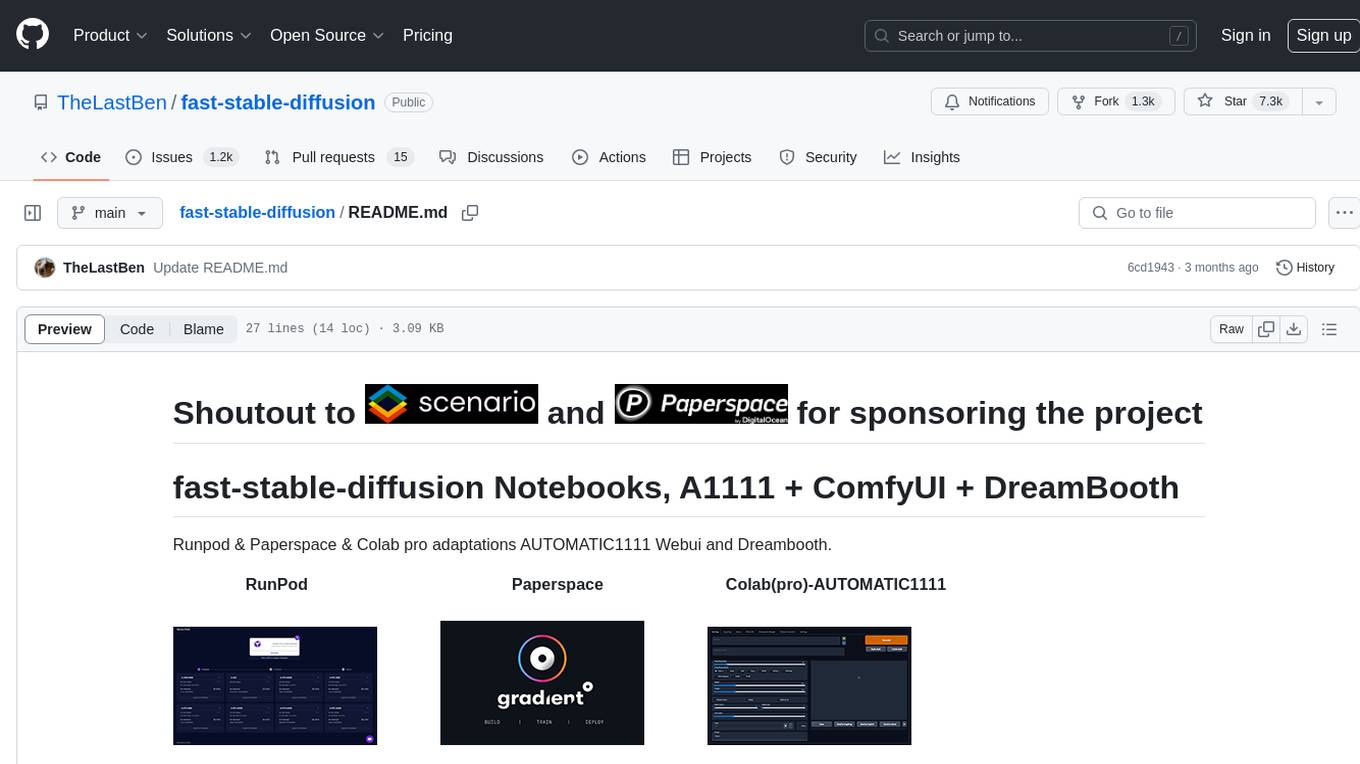
fast-stable-diffusion
Fast-stable-diffusion is a project that offers notebooks for RunPod, Paperspace, and Colab Pro adaptations with AUTOMATIC1111 Webui and Dreambooth. It provides tools for running and implementing Dreambooth, a stable diffusion project. The project includes implementations by XavierXiao and is sponsored by Runpod, Paperspace, and Colab Pro.
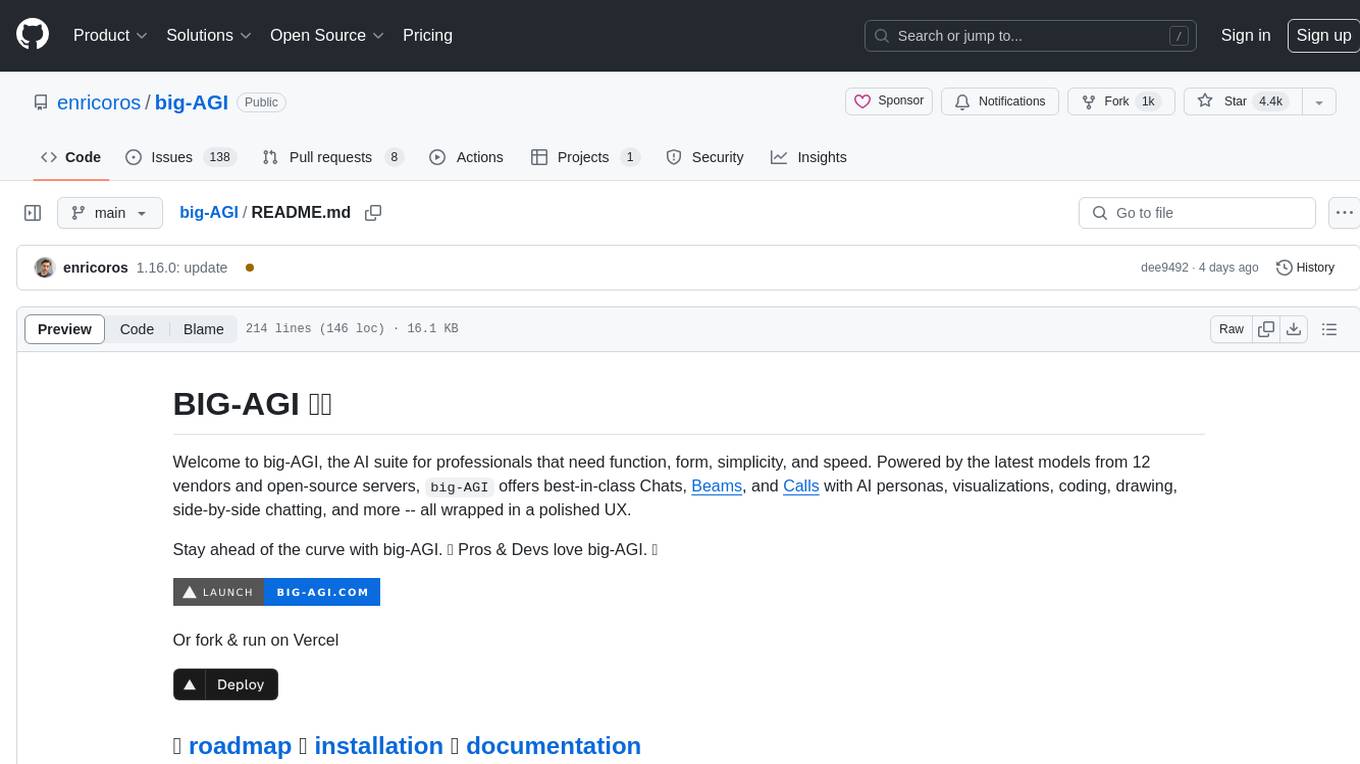
big-AGI
big-AGI is an AI suite designed for professionals seeking function, form, simplicity, and speed. It offers best-in-class Chats, Beams, and Calls with AI personas, visualizations, coding, drawing, side-by-side chatting, and more, all wrapped in a polished UX. The tool is powered by the latest models from 12 vendors and open-source servers, providing users with advanced AI capabilities and a seamless user experience. With continuous updates and enhancements, big-AGI aims to stay ahead of the curve in the AI landscape, catering to the needs of both developers and AI enthusiasts.
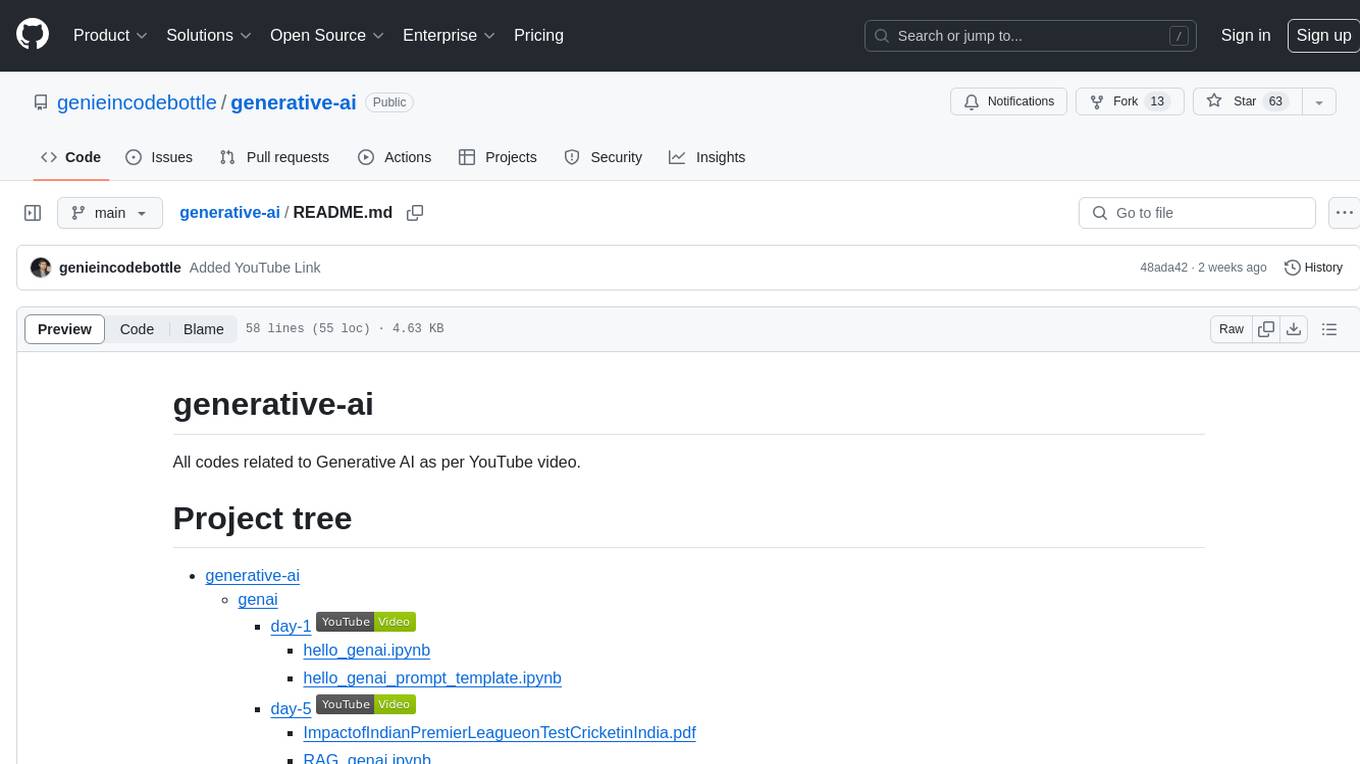
generative-ai
This repository contains codes related to Generative AI as per YouTube video. It includes various notebooks and files for different days covering topics like map reduce, text to SQL, LLM parameters, tagging, and Kaggle competition. The repository also includes resources like PDF files and databases for different projects related to Generative AI.
For similar jobs
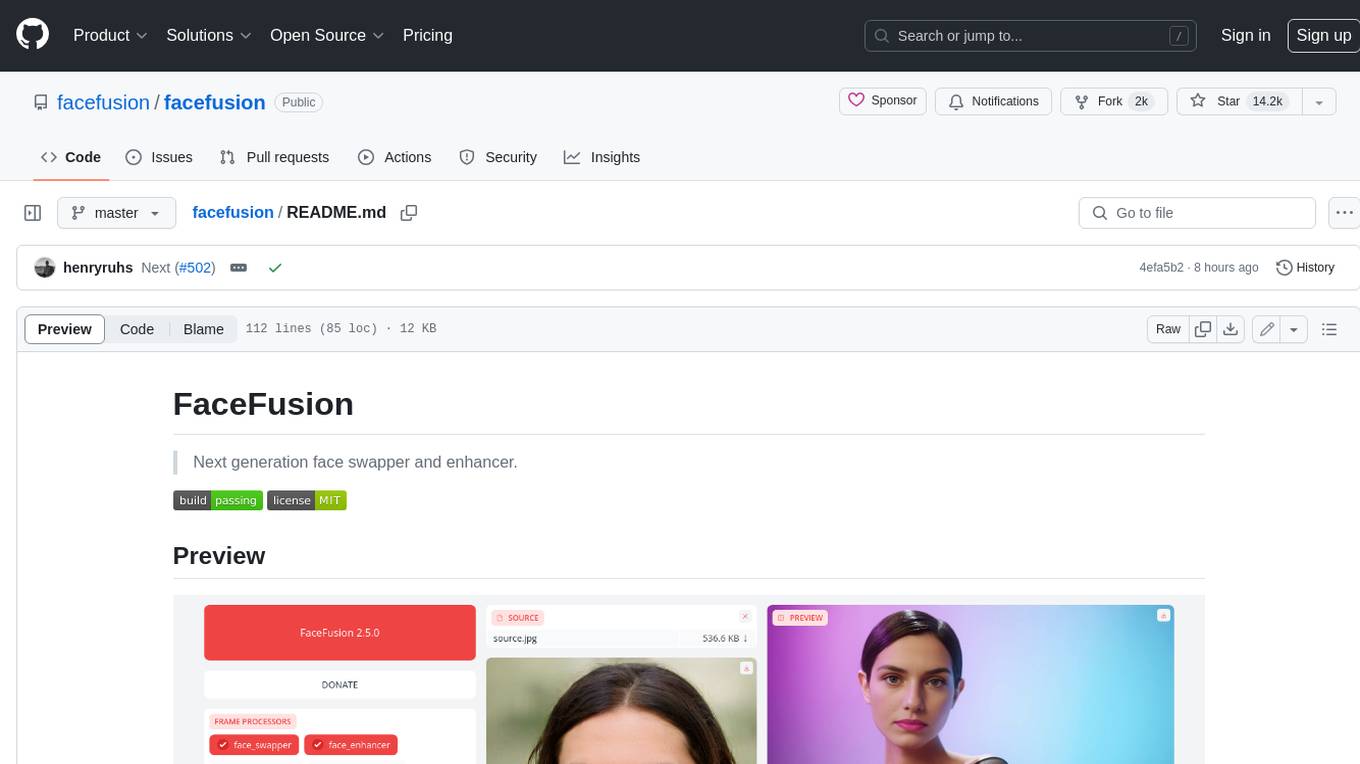
facefusion
FaceFusion is a next-generation face swapper and enhancer that allows users to seamlessly swap faces in images and videos, as well as enhance facial features for a more polished and refined look. With its advanced deep learning models, FaceFusion provides users with a wide range of options for customizing their face swaps and enhancements, making it an ideal tool for content creators, artists, and anyone looking to explore their creativity with facial manipulation.
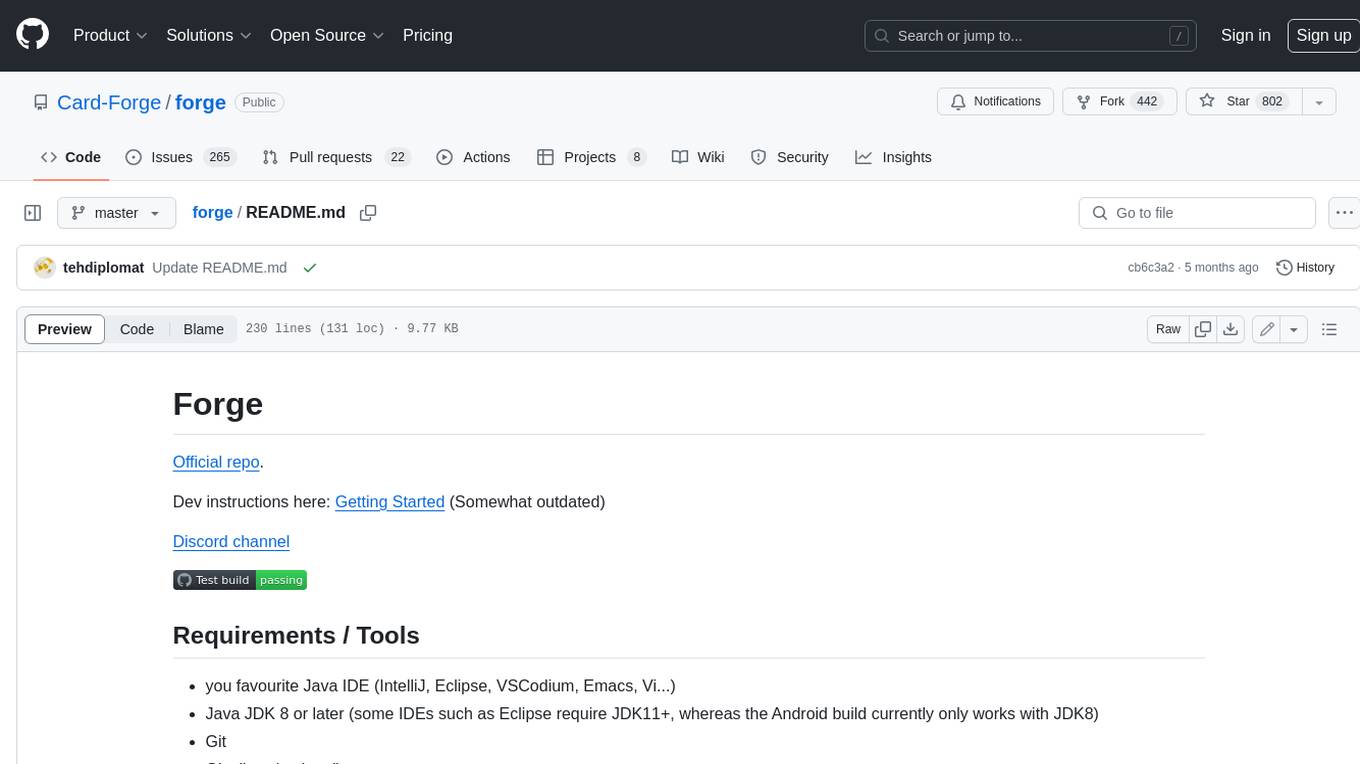
forge
Forge is a free and open-source digital collectible card game (CCG) engine written in Java. It is designed to be easy to use and extend, and it comes with a variety of features that make it a great choice for developers who want to create their own CCGs. Forge is used by a number of popular CCGs, including Ascension, Dominion, and Thunderstone.
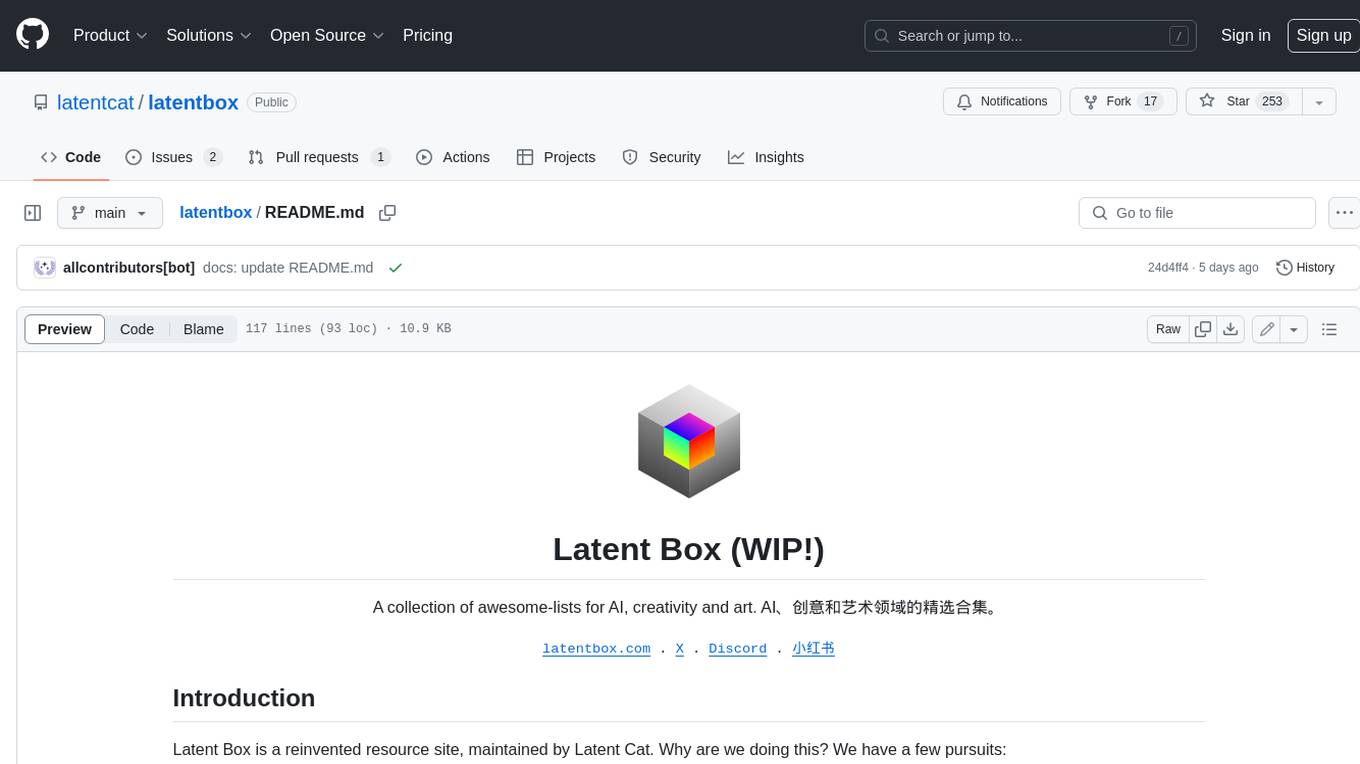
latentbox
Latent Box is a curated collection of resources for AI, creativity, and art. It aims to bridge the information gap with high-quality content, promote diversity and interdisciplinary collaboration, and maintain updates through community co-creation. The website features a wide range of resources, including articles, tutorials, tools, and datasets, covering various topics such as machine learning, computer vision, natural language processing, generative art, and creative coding.
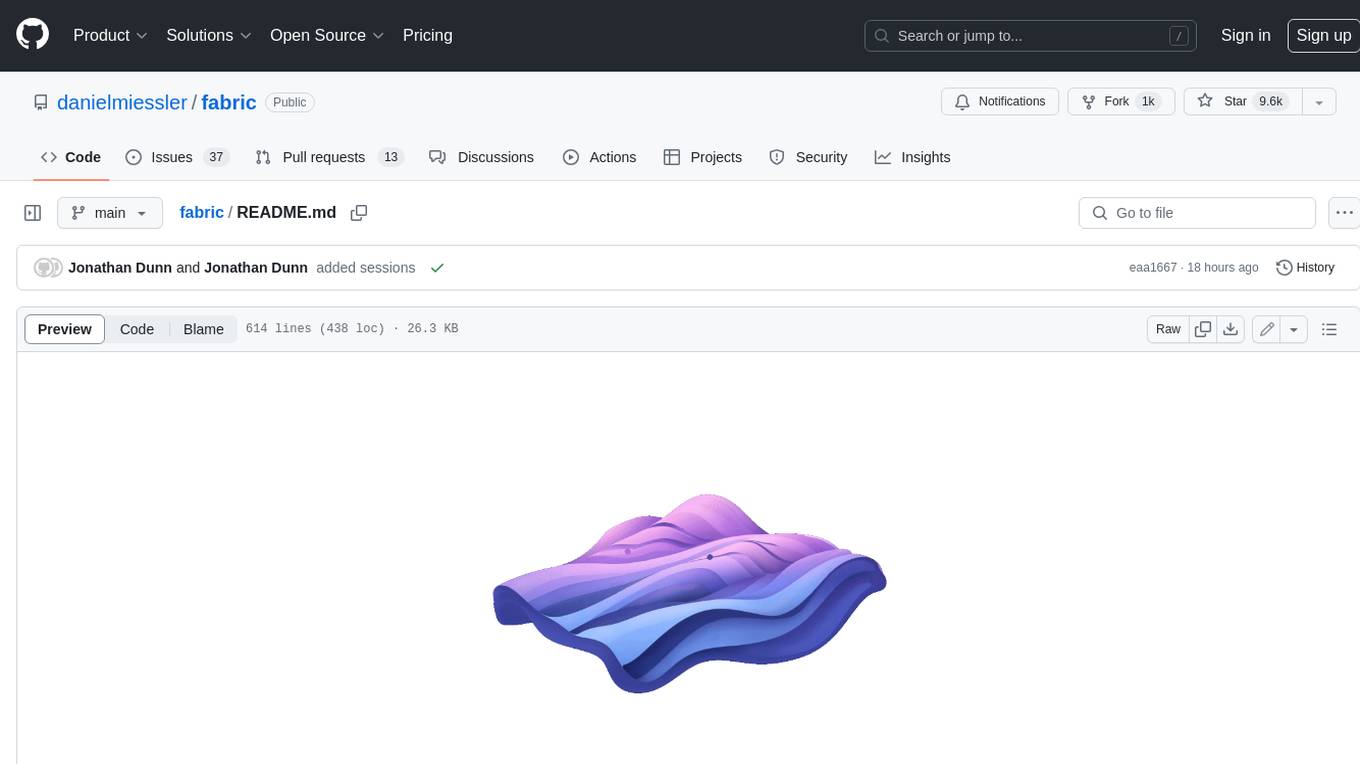
fabric
Fabric is an open-source framework for augmenting humans using AI. It provides a structured approach to breaking down problems into individual components and applying AI to them one at a time. Fabric includes a collection of pre-defined Patterns (prompts) that can be used for a variety of tasks, such as extracting the most interesting parts of YouTube videos and podcasts, writing essays, summarizing academic papers, creating AI art prompts, and more. Users can also create their own custom Patterns. Fabric is designed to be easy to use, with a command-line interface and a variety of helper apps. It is also extensible, allowing users to integrate it with their own AI applications and infrastructure.

ColorPicker
ColorPicker Max is a powerful and intuitive color selection and manipulation tool that is designed to make working with color easier and more efficient than ever before. With its wide range of features and tools, ColorPicker Max offers an unprecedented level of control and customization over every aspect of color selection and manipulation.
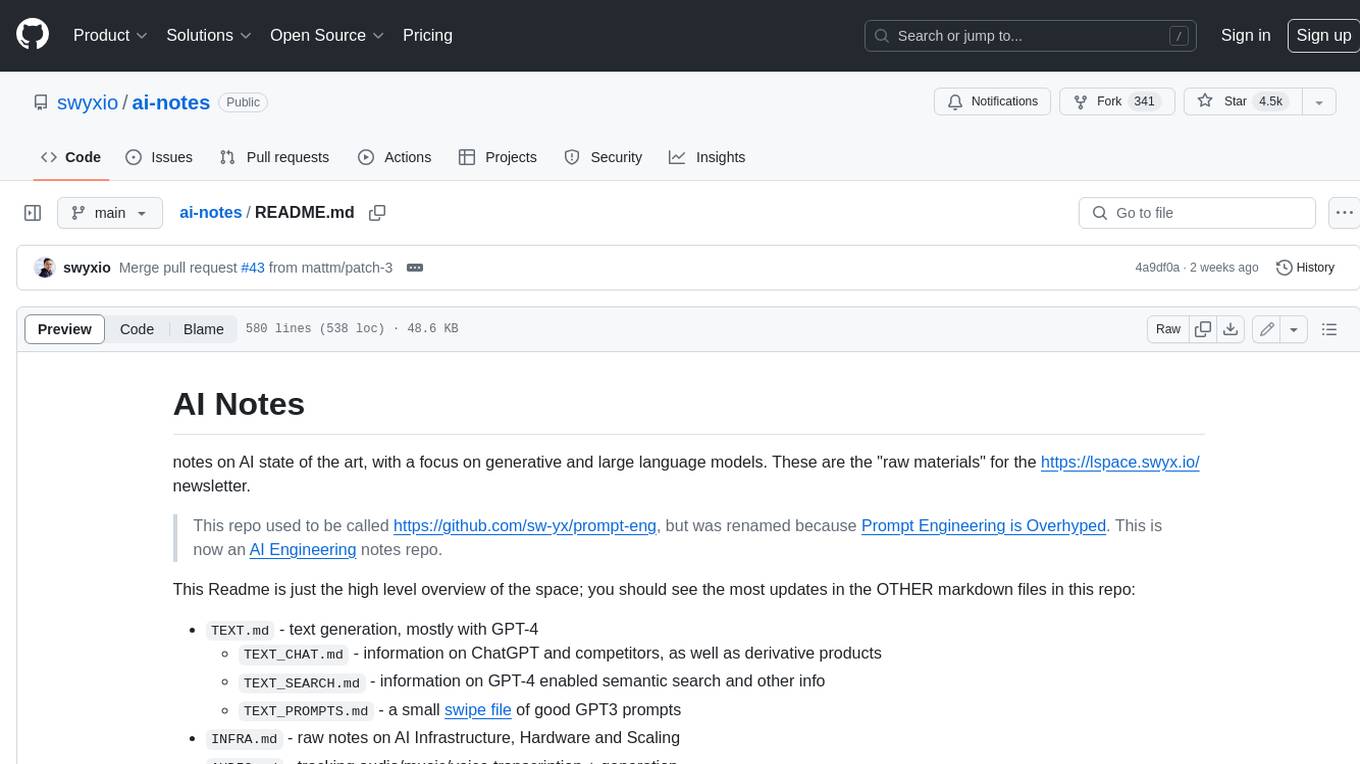
ai-notes
Notes on AI state of the art, with a focus on generative and large language models. These are the "raw materials" for the https://lspace.swyx.io/ newsletter. This repo used to be called https://github.com/sw-yx/prompt-eng, but was renamed because Prompt Engineering is Overhyped. This is now an AI Engineering notes repo.

Neurite
Neurite is an innovative project that combines chaos theory and graph theory to create a digital interface that explores hidden patterns and connections for creative thinking. It offers a unique workspace blending fractals with mind mapping techniques, allowing users to navigate the Mandelbrot set in real-time. Nodes in Neurite represent various content types like text, images, videos, code, and AI agents, enabling users to create personalized microcosms of thoughts and inspirations. The tool supports synchronized knowledge management through bi-directional synchronization between mind-mapping and text-based hyperlinking. Neurite also features FractalGPT for modular conversation with AI, local AI capabilities for multi-agent chat networks, and a Neural API for executing code and sequencing animations. The project is actively developed with plans for deeper fractal zoom, advanced control over node placement, and experimental features.
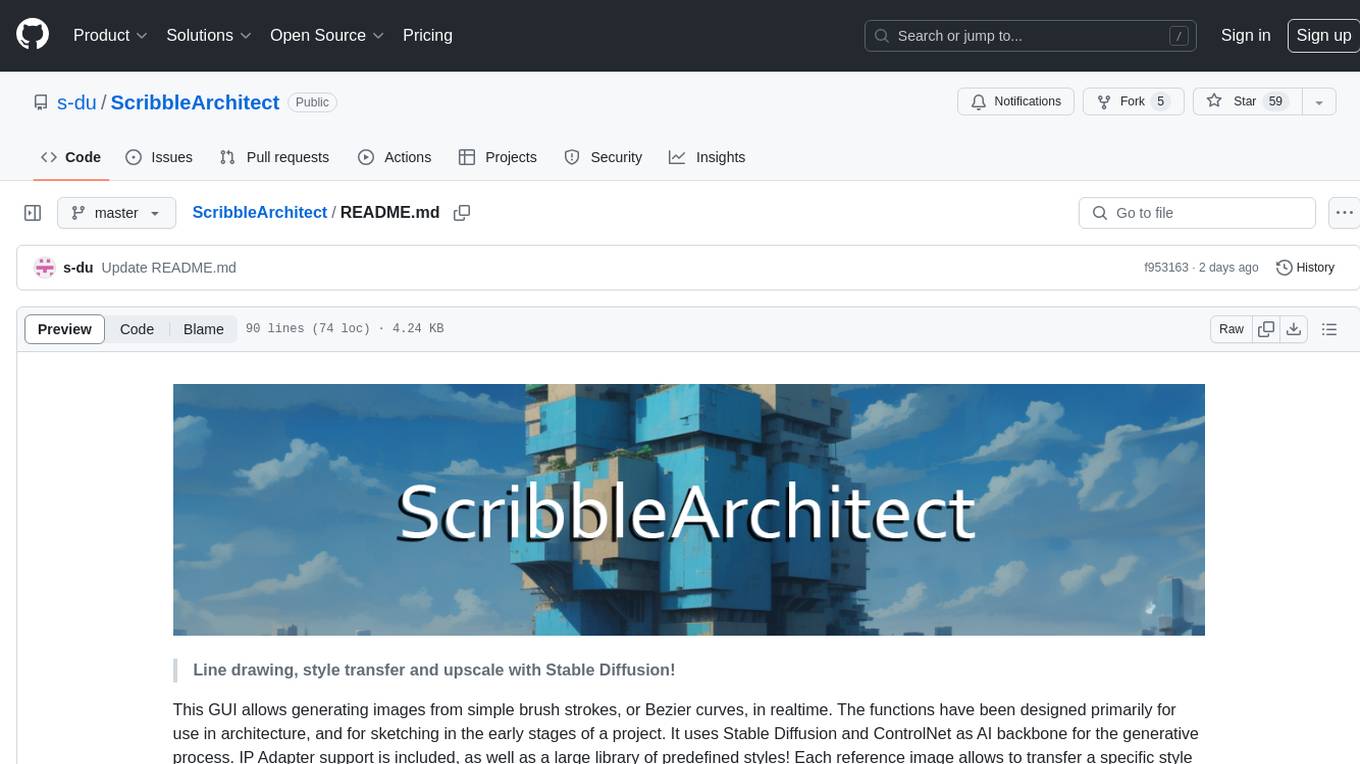
ScribbleArchitect
ScribbleArchitect is a GUI tool designed for generating images from simple brush strokes or Bezier curves in real-time. It is primarily intended for use in architecture and sketching in the early stages of a project. The tool utilizes Stable Diffusion and ControlNet as AI backbone for the generative process, with IP Adapter support and a library of predefined styles. Users can transfer specific styles to their line work, upscale images for high resolution export, and utilize a ControlNet upscaler. The tool also features a screen capture function for working with external tools like Adobe Illustrator or Inkscape.

